
Edward Winter

‘Burn this letter, Fiske, and forget the contents.’ (Letter from F.M. Edge to D.W. Fiske)
Given the interest in the relationship between Frederick Edge and Paul Morphy and, more generally, the Staunton-Morphy affair, an overview is offered here of historians’ previous efforts to set out the facts and analyse the issues and personalities involved. Included too are the fruits of our own researches in Chess Notes into Edge’s background, together with some suggestions for further reading.
Edge wrote many non-chess books on British and American politics and history, of which the most readily available today is Slavery Doomed (originally published in London in 1860 but reprinted by the Negro Universities Press, New York, in 1969). His only chess book, on Morphy, was published in two editions:
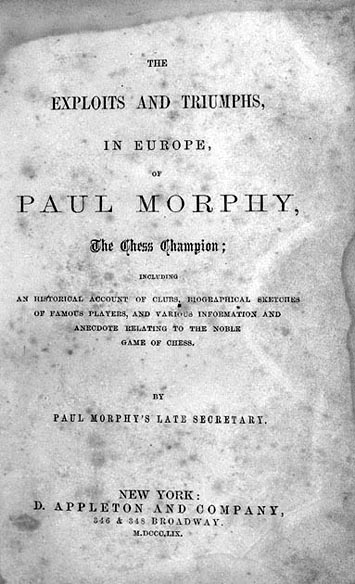
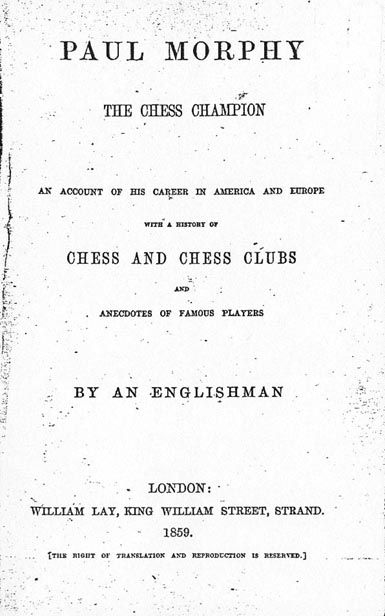
The US edition was reprinted in 1973 by Dover Publications, Inc. and by Moravian Chess in the Czech Republic circa 2001. In a brief feature on the book pages of the October 1974 CHESS, reference was made to the divergent texts, and David Lawson published a lengthy factual reply on pages 102-103 of the January 1975 issue. He also discussed the different editions in his subsequent biography of Morphy (see page 190), as well as in his six-page Introduction to the Dover reprint of Edge’s book, which also dealt with the relationship between Morphy and Edge. It began (page v):
‘This book by Frederick Milne Edge gives us our closest personal look at Paul Morphy. No other contemporary could have provided more information, with the possible exception of Morphy’s lifelong friend Charles A. Maurian; but Maurian merely gave some interviews many years later, when the freshness of his contact had passed.’
Elsewhere in the Introduction (pages vii-viii), Lawson wrote:
‘Whether Edge acted as Morphy’s valet as well as his secretary in England (as he very evidently did in France until the last few weeks there) is not clear, but most likely he did for part of the time. It is possible that Edge contributed to the strain that developed between Morphy and Staunton, although it is not at all apparent in his first letters to Fiske reporting Morphy’s activities. Morphy’s dislike for letter writing and details allowed Edge to become a large factor in his life in England and France. But for Edge, New York and New Orleans would have had almost no word about Morphy’s doings except for the reports on some of his games in the London papers. And certainly without Edge many games would not have been recorded and given to the press.
Also, without Edge there would have been no rebuttal to Staunton’s unfair or unsportsmanlike charges concerning the chess match between him and Morphy that all Europe was waiting for.’
Lawson also remarked (page ix):
‘We owe much to him [Edge], for the match with Anderssen and other games were due solely to his untiring efforts. With the Anderssen match in mind, Edge even schemed with Morphy’s doctor to keep Morphy from going home for the 1858 Christmas holidays, as he had promised his family.’
To give an idea of the content and style of Edge’s book, there now follow a few excerpts:
‘Although possessing but little skill as a player, I had a strong liking for the game, and determined that every thing in my power should be done to render the meeting [the New York, 1857 Congress] successful.’ (Pages 5-6)
‘I can think of no more suitable epithet for Morphy than to call him “the Newton of Chess”.’ (Page 15)
‘Zsen [Szén] went to Paris in 1831, and played some games with Labourdonnais at the odds of Pawn and Move, winning the majority. He then told the great Frenchman that he did not like playing for stakes as a general thing, but that he would propose to him a match of 21 even games for 200 francs; but Labourdonnais declined. And who will say he was wrong? for what pleasure could there be in sitting down day after day before the dullest player in Christendom, for the eventuality of 200 francs? Zsen was so frightfully slow, even in ordinary games, that he would have worn out 200 francs’ worth of his opponent’s pantaloons before the match was half through.’ (Page 61)
‘Morphy is a water-drinker, and Paris water would cure any Maine Liquor Law bigot of Teetotalism in a week.’ (Page 160)
‘The two principals being again face to face, Harrwitz commenced with his “same old two-and-sixpence” pawn to queen’s fourth …’ (Page 167)
‘On hearing this, I began to talk the matter over quietly with him [i.e. discussing with Morphy the prospect of meeting Anderssen], asserting that his voyage to Europe was useless, if he did not play Anderssen. All was to no effect. Morphy did not appear to have the slightest ambition, say what I would to him. He must be at home in December; he had promised to be there, and home he would go. Very well; Morphy and I were at daggers drawn and we began our fight. He said he would go, and I said he shouldn’t. He wanted to know how I could prevent him; I told him that all the clubs in Europe would stop him. “Very well”, answered he, “I’ll be stronger than all Europe.” “Bravo”, says I, “that’s spirited, at all events.” Says he – says I – says he – and Morphy went to sleep and I to work.
Without saying a word to anybody, I set to writing letters to all the leading Chess Clubs on the Continent and in England, informing them of the bad move Morphy was about to make, and requesting those in the interests of chess to induce him to remain, until at all events he had met Herr Anderssen. Now, the mere fact of Morphy staying, as the simple individual, was nothing; but it was something to make sure beyond all dispute that he was infallibly the best living player; and, in addition, to add many games to the finest pages of chess literature. I am happy to state that the different clubs thought as I did; so the result will prove.’ (Pages 183-184)
The reaction to Edge’s book in the main contemporary magazines was not particularly positive or extensive. An example is the Chess Monthly (New York), which was edited by Daniel Willard Fiske (1831-1904) with, for much of the time, Morphy listed as co-editor.
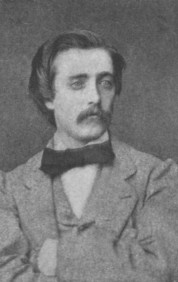
Daniel Willard Fiske
On page 316 of the October 1858 issue the Monthly had shown itself well disposed to Edge:
‘Mr Morphy left for Paris on 31 August, accompanied by Mr Edge. This gentleman deserves the thanks of Mr Morphy and of the American chess public for his kindness in relieving our countryman from many of the annoyances to which a stranger in a strange land is more or less subjected. He was one of the most efficient Secretaries of our Congress last year.’
The following year (May 1859 issue, page 165) Edge’s book was announced in the Monthly:
‘It is understood that a book entitled Paul Morphy’s Travels and Triumphs in Europe, is soon to be issued by an eminent publishing-house of New York. It will contain none of the champion’s games, but will be a pleasant and gossipy account of Mr Morphy’s tour, by one who had an excellent opportunity to observe all the incidents connected with it.’
Some of Edge’s letters to Fiske give the impression that the two were well acquainted and friendly, but despite Edge’s comments to Fiske about his forthcoming Morphy book the Monthly did not roll out the red carpet. The July 1859 issue (pages 204-207) had a book review section featuring five recent publications. Edge’s book was the fifth:
‘The work which stands last of those we have cited is altogether curious. Mr Morphy expressly disclaims any connection with it in any way or manner. There are many passages which might well have been omitted; there are many more which might well have been rewritten. The spelling of Szén might have been substituted for the remarkable orthography Zsen, and Mongredieu would have looked better as Mongredien, the real name of the distinguished President of the London Chess Club. But in spite of these and other imperfections there is a good deal of gossipy, anecdotal matter in the volume, thrown together in a rollicking, Bohemian manner, which will afford the reader a half-hour’s entertainment.’
Edge resented this review in the Monthly, as is shown by a letter he wrote to Fiske dated 7 November 1859 which we quoted in 2004 (C.N. 3396):
‘... When I read that cruel notice in the Monthly I sent you a communication which, in the heat of offended pride, I threatened to publish as a vindication of myself. Cooler judgment has shown me that it is nobler to suffer. Besides, I do not envy your feelings, and, above all, do I not envy Morphy’s. His southern pride may, for the moment, overpower generosity, but conscience must, sooner or later, torture him for returning malevolence for kindness. When flatterers cease to charm him, he will come to one who never flattered; and he will form a low opinion of those who abetted him against one who, in spite of any former difference, proved himself one of the best, if not the best, friend he ever had.
History neither lies nor forgets. Nobody could chronicle Paul Morphy’s feats in future ages without giving me my due ...’
The Edge work was mentioned only briefly in The Chess Player’s Chronicle (1859, page 254):
‘We have only been able to make a hasty perusal of the above volume, which appears to be written in a lively style, free from exaggeration, and therefore very likely to find favour with the general as well as the chess-loving public.’
At that time Staunton was no longer connected with the Chronicle, but he called Edge’s book ‘a contemptible publication’ on page 501 of his book Chess Praxis (London, 1860).
Later on too, Edge was to receive a poor press in his homeland. On page 51 of the February 1906 BCM, H.J.R. Murray (1868-1955) described Edge’s book as ‘rather ill-natured’. The July 1937 issue of the same magazine (pages 353-354) had this remark by Murray:
‘Sarratt is said to have been a schoolmaster, but apparently on the authority of F.M. Edge, most unreliable of writers: Hazlitt’s evidence rather tells against Edge. Edge again is our only authority for the pretty, but improbable legend that Sarratt had played with Napoleon, and compounded the struggle between pride and courtesy by drawing every game. We have no reason to think that Sarratt was ever out of England.’
Murray wrote detailed articles about Staunton in the 1908 BCM (November, pages 465-470 and December, pages 513-522). On page 518 he described Edge’s book as ‘a work which deals with the Staunton-Morphy episode in a strongly anti-Staunton manner’.
Edge’s name also cropped up, of course, in two books by P.W. Sergeant (1872-1952): Morphy’s Games of Chess (various editions from 1916 onwards) and Morphy Gleanings (London, 1932). Both works have been reprinted by Dover Publications, Inc., the latter under the title The Unknown Morphy.
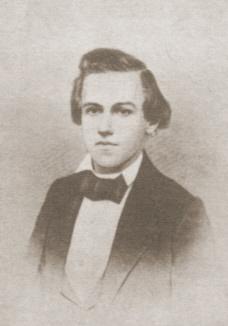
Paul Morphy
Morphy’s Games of Chess contained the following footnote on page 13 (concerning Staunton’s participation in the Birmingham, 1858 tournament):‘Edge, though English by birth, was very biased against Staunton; but we can hardly think that his prejudice went so far as to allow him to falsify the evidence.’
Sergeant also made a reference to Edge on page 101 of his book A Century of British Chess (London, 1934):
‘F.M. Edge, who was Morphy’s secretary in Europe, alleges that Staunton had told Morphy he was not playing at Birmingham. Edge, however, is not altogether trustworthy, being bitterly prejudiced against Staunton.’
In a footnote on the same page, Sergeant wrote:
‘B. Goulding Brown (BCM, June 1916) does not hesitate to call him “a liar”. He attributes to Edge Morphy’s non-competition at Birmingham. […] I must say that my own reading of Edge did not lead me to think him a liar; though I cannot deny his anti-Staunton bias. Staunton reciprocated the feeling, for when he wrote that he feared Mr Morphy was in very bad hands he certainly referred to Edge.’
The article in question by B. Goulding Brown (1881-1965) was given on pages 191-194 of the June 1916 BCM. It discussed many points arising from Sergeant’s first book on Morphy and included, on page 192, the following:
‘The whole story of Staunton’s depreciation of Morphy (before the rupture and Morphy’s appeal to Lord Lyttelton) is simply an impudent invention of Edge’s, and fully justifies Staunton’s denunciation of Edge’s book in the Praxis as “a contemptible publication”. With unparalleled effrontery Edge asked his readers not to take his word for granted, but to turn up the file of the Illustrated and see for themselves. I have done so, and I find him a liar. And I could wish that Mr Sergeant had done the same, before he penned his tremendous indictment of the greatest personality in English chess, and the central figure of the chess world from 1843-1851.’
The issue at stake was a claim by Edge about Staunton’s annotations of Morphy’s games in the Illustrated London News during a specific period. In the 1980s Frank Skoff examined Goulding Brown’s charge against Edge, notably in the APCT News Bulletin of May-June 1985 (pages 115-118). He reviewed each of Staunton’s columns and concluded:
‘Besides being a lover of literature and a Latin scholar, Brown was a history coach at a well-known university. He left all his skill as a historian behind him in his denunciation of Edge, which, to be charitable, was an act of gross incompetence since he knew better and should have checked the primary source, Edge’s own words.’
In C.N. 957 Skoff wrote:
‘I also read the 1916 BCM article by Goulding Brown and found it nonsensical, some of it also being refuted by Lawson in his book.’
And:
‘As for Goulding Brown, I must add that the evidence he produces to call Edge a “liar” would never pass a court test, or any other rational proof. What he does is select the brief quotes that are favourable to his case, ignoring those that are not.’
Skoff’s four-part article in the APCT News Bulletin, a review of the Oxford Companion to Chess, focussed on the Staunton and Morphy entries. It was published in the following issues: February 1985, pages 43-44; March 1985, pages 60-62; April 1985, pages 86-88; May-June 1985, pages 115-118. In addition, the January 1986 issue (page 11) carried a brief letter from Kenneth Whyld (1926-2003), together with a response to him by Skoff. Only the latter mentioned the Brown affair:
‘My review demolished a salient foundation of the Staunton entry: Goulding Brown’s claim in 1916 that Edge was “a liar” and therefore any of his statements could be tossed aside as unreliable. That libelous claim – an easy way to avoid considering evidence one doesn’t like – was followed, in one form or another, by other British journalists to this day. You operated under the same influence by describing Edge pejoratively as “a copy seeking journalist” and therefore the cause of all the trouble between Staunton and Morphy, as though Staunton’s conduct had been angelic. Ignoring that conduct or “distilling” it inaccurately can only result in distortion and inaccuracy. Most astoundingly, until my review, Brown’s libel had remained unexamined for nearly 70 years; before then no one checked it for validity and soundness. How could you (or any other journalist) have missed the obvious bias and incompetence of Brown?’
As indicated by the various quotations elsewhere in the present article, many different opinions on Edge’s work have been expressed. One of the most positive was from Bob Meadley, in C.N. 1480:
‘It’s a terrific book which includes a unique chapter on the history of English Chess as well as the boring Staunton affair. But it has great style, bubbling along with good stories. A chess classic.’
The two letters from Edge to Fiske presented in C.N. 840 and C.N. 1358, in 1984 and 1987 respectively, gave rise to much analysis and discussion in Chess Notes. James J. Barrett, who supplied Edge’s letter of 3 April 1859, commented in C.N. 840:
‘The text shows Edge to be a complicated man. His pushiness is well illustrated in the interchange with Mongredien. Although the latter speaks directly to Morphy, Edge did not let him answer. There are valuable glimpses of Morphy at a very personal level. The relating of his attitude towards Edge as a slave, at least in Edge’s mind, is an electrifying revelation (or opinion).’
Barrett added some further thoughts in C.N. 1269:
‘Ruminate about this statement of Edge’s: “… and I write a work which will live as long as the game lives and will make him more famous than anything he has ever done” [my emphasis – J.J.B.]. This is possibly the most remarkable insight into Edge’s state of mind at that time in the whole letter. An honorable mention might go to the masochistic/martyr-complex implications of the passage beginning “and besides, there is a sweet satisfaction …” etc. Psychoanalyst Fine would have a field day.’
In C.N. 881 G.H. Diggle (1902-93) remarked:
‘The Edge letter is a great “find”, and I think it justifies my estimate of him in the 1964 BCM, with which it seems Mr Barrett largely agrees, though I was wrong in saying that Edge and Morphy did not separate till April 1859 – the rift came three months earlier. It is curious that David Lawson did not publish the whole, which sheds so much more light on his relations with Morphy. (Of course, the letter tells against Lawson’s rather favourable estimate of Edge.)’
The same C.N. item had a contribution from Meadley, from which a brief extract is given here:
‘That certainly was an eye-popping letter of Edge’s to Fiske, and to some extent it is a pity David Lawson did not publish it in its entirety in his fine book Paul Morphy The Pride and Sorrow of Chess. As you know, the extract he did publish on page 148 of that book contains none of the startling material in the letter, and one can assume from that that he wished to gloss over some of the traits of Morphy by not including them.’
We concluded that C.N. item’s discussion of the letter with a comment of our own:
‘For the record, J.J. Barrett informs us that he received the original Edge letter from David Lawson for inspection. Our correspondent xeroxed it and returned it to D.L. We personally believe that Mr Lawson’s decision not to quote the real “meat” of the Edge communication in what aimed to be a definitive biography of Morphy was a grave misjudgement.’
In a subsequent contribution (C.N. 1270) Barrett wrote:
‘Much more light needs to be cast on the “Edge to Morphy” letter quoted in the Oxford Companion to Chess and referred to in C.N.s 840 (page 111) and 957 (page 55) – “I have been a lover, a brother---” etc. Nothing less than the quoting of the full text will satisfy the needs of accurate chess history. If this letter was ever delivered to Paul Morphy does it make sense that both he and his family would have preserved it if it in any way compromises the man?’
That was written in 1986, at which time all (or, rather, almost all) Chess Notes readers, as well as the Editor, were under the misapprehension that the letter which included the word ‘lover’ had been written to Morphy himself. The following year the full text of the letter, dated 25 March 1859 and addressed to Fiske, was published in C.N. 1358, courtesy of Skoff. The most significant passage, i.e. the conclusion, reads as follows:
‘... Now, Fiske, I can from the depths of my soul declare, looking God in the face, that had it not been for me, you wouldn’t have seen 20 of Morphy’s games - the correspondence with Staunton wouldn’t have been written, and Morphy would have gone back humbugged and a laughing stock. I made him stay and play Anderssen, and I have stood invariably between him and his enemies; and conspiracies have been dangerous in Paris, I assure you - in the salons - by Morphy’s own fault. I can say, never did man more devotedly serve another. I neglected my wife for him, accompanied him to Paris and left her till broken-hearted she came to fetch me back. I put a coldness between myself and all my family which only years will heal, and I don’t, even now, know why. I am not a chess-player, I am not an American, I have nothing to hope for from Morphy, and I would not say what I have herein written, to anybody but you, and you will be guilty of an infamous act if you let anyone see this letter.
I shall watch over Morphy until he leaves Europe, and when he leaves I can say - “What you are outside of chess, I have made you. Your tremendous laziness, but for me, would have obliterated all your acts. I have taken your hundreds of letters out of your pockets even, and answered them, because you would have made every man your enemy by not replying. I made you stay and play Anderssen, when you wanted to leave. I nursed you when ill, carrying you in my arms like a child. I have been a lover, a brother, a mother to you; I have made you an idol, a god - and now that you are gone, I never -- but I will not finish. I say this to you, Fiske, but I have said nothing of it in my book; there Morphy is all in all, the Alpha and Omega, the beginning and the end; all that is great, magnanimous, true, noble and sublime, and Morphy will not open its pages without a blush, or close them without a sigh. - Burn this letter, Fiske, and forget the contents. - Yrs. very truly
Fred’k Edge.’
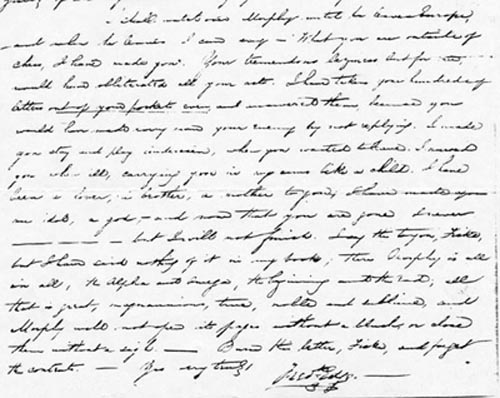
Publication of the letter was warmly welcomed by readers, and in C.N. 1480 Meadley wrote:
‘Again Chess Notes has astounded the chess history lovers of the world with the revelations in Edge’s letter to Fiske, provided by Frank Skoff in C.N. 1358.’
The discussion focussed, naturally enough, on the ‘lover’ issue, in the light of the brief extract which the Companion had published in 1984 (page 217). Regarding the omission of the name of the recipient, making it seem that Edge was writing to Morphy, Whyld wrote in C.N. 1440:
‘We were conscious of this and discussed it with the editorial staff of the Oxford University Press. We felt that nobody who knew much about Morphy would be misled, because the date of March was after Morphy and Edge had broken all contact, but the average reader would most likely take it as being addressed to Morphy. The quotation was the epitome of Edge’s attitude to Morphy and after careful consideration was judged to be appropriate.’
And from the same item:
‘The quotation is very clearly metaphorical and not a statement of homosexuality, but possibly it might put the thought into the reader’s mind for the first time. I cannot see the benefit of examining Morphy’s sexual proclivities.’
In C.N. 1569 Whyld wrote:
‘From Edge onwards, writers have noted Morphy’s effeminate appearance and manner, and obviously the possibility of homosexuality must have been pondered for more than a century. Our quotation may have caused some readers to ask this question. That is nothing new.
If I had to make a choice, I would guess that Morphy was celibate. That is hardly likely to please Skoff, because he will probably know that psychoanalysts regard voluntary celibacy as a greater perversion than homosexuality.’
Further remarks by Whyld appeared in C.N. 1932:
‘The quotation needs seeing in full. Edge wrote, “I have been a lover, a brother, a mother to you; I have made you an idol, a god …”. Is it rational to read this as saying, “I have been, only in the figurative sense of course, your brother and mother, but I have been literally your lover, and what’s more, in the mid-twentieth-century meaning of the word and not that of the mid-nineteenth-century”? Such a perverse interpretation should be too foolish to merit contemplation, and certainly does not deserve detailed discussion. When hero-worship takes over, common sense seems to fly out of the window and the eyes mist over, preventing the sentence from being read in full.’
That item (C.N. 1932) was one of the very few in which we intervened in the debate:
‘… we wish to point out that our earliest knowledge of an alleged homosexual relationship between Morphy and Edge was about 18 months before the Companion was published. On 25 November 1982 Mr Whyld wrote to us: “I have a great deal about Edge, some of which I have doubts about making available for publication (such as his claim to have been Morphy’s lover)”.’
Also in C.N. 1932, Louis Blair wrote:
‘So what is the purpose of the lover quote in the Companion? Consider the chronology. 1982: [Whyld] writes to Edward Winter, mentioning that Edge claimed to have been Morphy’s lover. 1984: the Companion is published. In one paragraph, there is the claim that Morphy could have passed for a woman, an Edge quote comparing Morphy to Narcissus, and another Edge quote talking about being Morphy’s lover. No explanation for the quotes is given, although the authors do find that they have the space to give an (unjustified) interpretation of an Anderssen quote. 1985, 1986: A considerable stir is caused by the lover quote. [Whyld] has nothing to say on the subject. For example, he does not tell us that the quote was part of a letter to a third party, not Morphy. 1987: The year that the complete letter is published. Many feel that knowledge of the intended recipient of the Edge letter completely changes the conclusions that might be drawn from the quote. [Whyld] rushes to tell everyone that it was never the intention of [Whyld and Hooper] to suggest homosexuality. Whyld tells us how we could have deduced that the letter was not written to Morphy. (A fallacious argument as the quote sounds like just the sort of thing that might have been written by Edge to Morphy after the break-up.) [Whyld] tells us how we could have deduced that Edge was not using the word lover in a literal sense. (Another fallacious argument as it is clear that Edge is talking about his behavior towards Morphy when he uses the words mother, brother and lover.) …’
But the strongest critic of the Companion’s treatment of the Edge letter was Skoff. A digest of his comments follows:
‘Now that the full context of the infinitesimal quote has appeared in C.N., the air will be cleared (I hope). Nonetheless, though I hate to sound cynical or pessimistic, the smear of Morphy will live on forever in print under the prestigious banner of the Oxford University Press in the Companion; it has already spread to so many places in the chess world that its eradication will be impracticable. So much for justice.’ (C.N. 1417)
‘After I was fortunate enough around January 1987 to secure a copy of the complete text of the letter from another source I was astonished to discover it had no sexual material at all; it was not addressed to Morphy as the insinuendo implied. At last the insinuendo was revealed as a gross error in construction, a cunning deception, a phantasm, a hoax, a fabrication, a humbug, a flim-flam, a disgrace – take your choice.
In his letter of 3 March 1987 Whyld made an astounding assertion (also given in C.N. 1417): “You appear to be the only one who has read a suggestion of homosexuality in the quote”. Yet he must have known that this assertion was untrue because it was touched on in various media read by him: 1) C.N. 840 2) C.N. 957 and 3) C.N. 1270: also once in the BCM (January 1985). Knowing of these instances, he was under obligation to clarify the matter, but he chose to remain silent, thereby sealing his guilt.’ (C.N. 1499)
‘In C.N. 1569 K.W. stoutly asserts, “There is no secrecy other than the name of the letter’s owner ten years ago”, a statement that takes one’s breath away […] as it ignores the obvious fact that the contents of the letter itself were kept secret from the scrutiny of the public, misleading it into thinking that Edge was writing to Morphy and thus backing up the desired insinuendo. The secrecy and the insinuendo would have remained so had I not discovered the letter and published it in C.N.’ (C.N. 1757)
‘I must point out too that if he [Whyld] had been honest and given the recipient’s name (Fiske), which the letter owner would have permitted, the insinuendo would then have been transferred to him [Fiske] but would have made no sense in the context of the insinuendo paragraph; besides that, F. was not his target. Thus by not giving the whole truth (see C.N. 1417) and by placing only M.’s name before the quote, [Whyld] slyly and cunningly shifted the smearing insinuendo on the back of M. And when readers fell into the trap by referring to the letter as being from Edge to Morphy (see C.N. 840 Nov.-Dec. 1984, 957 & 1270), [Whyld] did not correct their mistake, as he was obliged to do, but let it take hold and grow inside the mind of the general public, the basic aim of all smearers, until the spring of 1987 (C.N. 1358), when the full letter was printed and revealed the truth to C.N. readers for the first time. How Machiavellian!’ (Skoff letter to Chess Notes, 17 November 1989)
In the revised (1992) edition of the Companion Edge had an entry of his own, and the ‘lover’ passage (19 words) was given there (page 120). Despite the earlier protestations of readers, Fiske was still not mentioned as the recipient of the letter. Moreover, since the full text of Edge’s letter had been given in Chess Notes in 1987, the Companion’s use of the word ‘unpublished’ was wrong. Nor were these matters corrected in the 1996 paperback edition of the Companion.
The second issue of Chess Notes (March-April 1982 – C.N. 90) contained this paragraph:
‘Very little is known about the personal life of F.M. Edge. After his connection with Morphy was severed he returned to general journalism/book-writing, but we have never even been able to find a notice of his death. It seems that his prolific pen dried up in 1869, his final book being Great Britain and the United States: A Letter to the Right Honourable William Ewart Gladstone M.P., published by William Ridgway, 1869. The end of the letter reads: London, November 15th 1869. How did Edge’s life finish?’
The September-October 1983 issue of Chess Notes (C.N. 524) included some information from Whyld. Edge’s death certificate stated that he died on 28 May 1882 (i.e. about two years before Morphy) at King’s College Hospital, London, aged 52. He was described as a literary author of 14 Hanway Street, Oxford Street, London.
Following the increased interest in Edge resulting from the publication in C.N. 840 of a letter to Fiske, more delving was called for, but there was little of substance to report in the January-February 1985 issue of our magazine (C.N. 881):
‘Our attempts to find out more about Edge have so far been crowned with failure. A hasty (but, we hope, accurate) check of British marriages between 1846-1858 has revealed only one Frederick Edge, definitely not our man. Armed with the information in C.N. 524, we looked without success for a reference to Edge in the 1881 and 1882 Registers of Electors. Nor could we find a note of his death in the main local newspaper, the Camden and Kentish Towns Gazette. Finally, the 1881 Census lists eleven people living at 14 Hanway Street, but Edge is not amongst them.’
However, later the same year (July-August 1985 Chess Notes – C.N. 1012) it proved possible to provide substantial information about Edge:
‘We have been trying to piece together a little more about Edge’s private life, the starting-point being King’s College Hospital, where he died on 28 May 1882 (C.N. 524), the cause of death being extravasation of urine. It was a painful end, as the record of the post mortem examination makes clear. We are not authorized to offer copies of this report, but interested (non-squeamish) readers may apply direct to: Mr A.J.B. Mussell, Archives Assistant, King’s College London, Strand, London WC2R 2LS, England.
The case-notes on Edge have not survived, so that might have been the end of the trail. However, although we had contacted King’s College Hospital only in connection with Edge’s death, Mr Mussell, with exemplary thoroughness, made a spontaneous check of King’s College’s academic records. By a remarkable coincidence, it emerges that Edge was a student there over 30 years previously, the archives revealing the following:
Frederick Milns Edge entered King’s College on 2 October 1850, being aged 20 on 29 May of that year. His parent or guardian was Mr Thomas Edge of 39 Vincent Square, Westminster, where Frederick was then also living. His previous education had been with the Rev. John Richardson, M.A., of Guernsey. The course for which he was entered was General Literature and Science, which could, if the student wished it and was prepared to undertake the extra work, lead to the Associateship of King’s College (AKC), a qualification which may be seen as being equivalent to a degree. At the same time, he was also entered for an additional course in chemistry, as an Occasional student. On 19 March 1851 he was further entered for the Matriculation course, which suggests that his previous education had not provided him with sufficient grounding for the curriculum of King’s. He left after a year (the normal attendance was three years) without any qualification, although this in itself was not unusual at that time. His reports for the year have survived, and are as follows:
Michaelmas Term 1850:
Divinity: R(egular), Imp(roving)
Chapel: R(egular)
Classics: D(iligent) & A(ble)
Mathematics: V(ery) A(ble) & des(irou)s to Imp(rove)
English Literature: Freq(uently) abs(ent) for ill(nes)sLent Term 1851:
Divinity: R(egular) at Lectures, ab(sen)t from several Ex(amination)s
Chapel: Freq(uentl)y Abs(en)t
Classics: fair
Mathematics: fair
English Literature: Often AbsentEaster Term 1851:
Divinity: Absent from every Examination
Chapel: Has not attended
Classics: Irregular
Mathematics: Not Regular
English Literature: Generally Absent(The letters in brackets have been supplied by Mr Mussell.)
One other note in the records: Edge did not return his locker key until 31 December 1853, and thereby forfeited his 5/- deposit. It was not usual for keys to be returned after a student had gone down, but to return one so long afterwards is perhaps a little out of the ordinary.
However, what is more striking is Edge’s age at entry; at 20 he was rather old, the average age at the time being 16-18.
King’s College also has correspondence from F.M.E.’s father, Thomas Edge. We have photocopies. Edge père was a manufacturer and installer of gas-lamps, and in the early days of the College seems to have been one of their principal contractors. His business was variously called the Gas Light Office, the Lamp and Chandelier Manufactory and the Gas Fitting Manufactory, but the address remains as 59 Great Peter Street. It will be recalled that it was from there that Frederick wrote the letter to Fiske given in C.N. 840.
The Archives Department of the Victoria Library (City of Westminster) has confirmed that Thomas Edge “appears to have begun as a Brassfounder and Gas apparatus manufacturer”. Various London directories show that in 1826-7 he was listed as a Brassfounder at 58 Great Peter Street and a Gas apparatus manufacturer at 59 Great Peter Street. By 1863 he was listed at 16 Regent Street (near to Horseferry Road), but the following year Thomas Edge Junior appears to have taken over the company, at the same address.
The 1851 and 1861 census returns for the Edge family home at 39 Vincent Square are of interest. Combined, they mention that Thomas Edge Senior (born 1792 or 1793) had six children who lived there at one time or another: Thomas, Mary Ann (b. 1823 or 1824), Frederick, Emily (b. 1831 or 1832), Alfred (b. 1832 or 1833) and Elizabeth (b. 1835 or 1836). Frederick is listed only in the 1851 Return: aged 20, Student, born Middlesex St John, Westminster. It has not, however, been possible to trace his baptism in the St John, Smith Square parish registers (St John, Westminster) in the year following his birth. [We subsequently found that Edge was christened at St Martin-in-the-Fields, Westminster, London on 19 July 1830. His mother’s name was recorded as Eleanor.]
The census returns indicate that Emily was born at St Helier, Jersey, the second link with the Channel Islands. This seemed unlikely to be a coincidence, given that the total population of Jersey and Guernsey in 1851 was under 87,000.
From the Guille-Allès Library, St Peter Port, Guernsey we learned that Frederick’s tutor, John Richardson (died 1856), was the Classics master at Elizabeth College, Guernsey from 1845-1847 and then, for an unknown period, Mathematical master. Later, he became curate of the Castel Parish Church. The Elizabeth College register, however, lists only Frederick’s brother, Thomas: “born at Westminster, November 24, 1818; son of Thomas Edge; left 1831. Gas engineer and gas meter and apparatus manufacturer”. Frederick may have become the private pupil of Rev. Richardson after the latter left the College.
The search for further details continues, but in the meantime there remain two discrepancies. Firstly, the death certificate appears to be in error in stating that Frederick Edge died at the age of 52, though in error by the slenderest of margins. The college archives say that he was born on 29 May 1830, while the death certificate records his demise as occurring on 28 May 1882, i.e. when he was 52 less one day. Secondly, the spelling of his middle name. While the death certificate has “Milnes”, the college records (for his education) give “Milns”, which also appears in the text of his Morphy book [page 112]. We increasingly feel that Milns is likely to be the correct version.’
In this connection it may be noted that the 1984 edition of the Companion (page 217) gave ‘Frederic Milnes’, the 1987 paperback version (page 217) had ‘Frederick Milnes’, and the 1992 edition (page 119) put ‘Frederick Milns’. The front cover and title page of the Dover reproduction of Edge’s book used Frederick ‘Milne’. It is certainly difficult to know how his second forename should be spelt. The title page of Slavery Doomed had ‘Milnes’. So did, for instance, England’s Danger and Her Safety, another Edge work (London, 1864). ‘Frederick Milnes Edge’ appeared on both the title page and page 31.
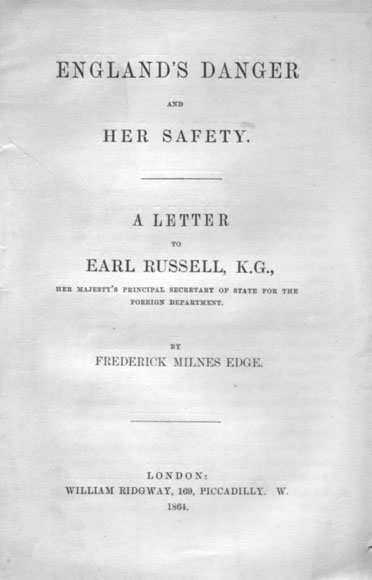
With the above biographical basics about Edge in place, the September-October 1985 Chess Notes (C.N. 1030) was able to add a few extra details regarding his father:
‘The 1851 census makes it clear that Thomas Edge’s company was sizable since it is stated that he employed 7 Clerks, 2 Foremen, 77 Men and 20 Boys. We have, in fact, now learned that he was responsible for the introduction of gas-lighting to both Jersey and Guernsey. This information comes from Gas in Jersey 1831-1981 compiled by Roger Long (published by the Jersey Gas Company Ltd in 1981). It records that T.E. was President/Chairman of the Jersey Gas Company from 1831 to 1856. From page 9 of the book: “In his English affairs Thomas Edge became bankrupt and on 30 September 1850 a receiver sold the St Helier gasworks to local trustees”. (N.B. 1850 is an error for 1856.) An article noting T.E.’s major contribution to gas-making in Guernsey is to be found in the Guernsey Evening Press and Star, 25 November 1980 (150th anniversary).’
Since the above was written (i.e. in the mid-1980s) no further biographical information of substance about Frederick Edge seems to have come to light.
David Lawson’s book Paul Morphy The Pride and Sorrow of Chess (New York, 1976) is one of the most detailed biographies of a chess master. It contains a large amount of information about the abortive attempts to arrange a match between Staunton and Morphy and the involvement of Edge. Lawson made use of many of Edge’s letters to Fiske:
On page 115 Lawson assessed the relationship between Morphy and Edge:
‘There has been some talk that Morphy was unduly influenced by Edge, especially on the matter of the Staunton match, but we have seen that Edge was more confident than Morphy that the match would ultimately take place. In any case, Morphy was a self-willed person, and he made his own decisions. Edge always played a subordinate role in Morphy’s affairs, and chess historians are greatly beholden to Frederick Milne Edge for his factual accounts of the events which occurred while he was with Morphy, which was practically all the time Morphy was abroad. This writer would agree with Philip W. Sergeant, who states in his book A Century of British Chess “that my own reading of Edge did not lead me to think him a liar”.
Edge was in effect Morphy’s shadow, acting as his secretary and companion. It is evident from his letters to Fiske and from his books that Edge was ever solicitous of Morphy, attending him in health and sickness, helping him with his correspondence, and even serving as his valet, carrying his underlinen to him, etc.’
The extract in Lawson’s book (page 188) from Edge’s letter to Fiske of 10 February 1859 gave Edge’s account of his break-up with Morphy:
‘You will perceive that I have quitted Paris, leaving Paul Morphy alone. The fact is – since his match with Anderssen he has quite forsaken chess and feeling that there was no longer any chance of his playing anyone, I knew I was of no further utility.’
Lawson then commented:
‘Of course Edge now had much more time to himself. But it would appear that there were other reasons for Edge’s leaving Morphy of which the former never spoke. Nowhere in Edge’s letters to Fiske or elsewhere is there any satisfactory explanation for Morphy’s coolness toward Edge, who had labored so diligently and faithfully for him. In the letter to Fiske of February 10 mentioned above, Edge says that toward the end of January he had begun work on a book about Morphy. Without doubt he wanted primarily to give the world the story of Morphy’s trials and triumphs in Europe, such that he knew no one else could furnish.
But Morphy disliked publicity of any sort, especially when it dealt with his chess activity. It is probable that Morphy had seen some of Edge’s manuscript and, disliking its treatment of the Staunton affair, had refused to sanction its appearance in book form. And Morphy also apparently objected to Edge’s treatment of other matters.’
No picture of Edge is known to exist. Below is a seldom-seen sketch of Morphy in Frank Leslie’s Illustrated Newspaper, 31 October 1857, page 345:
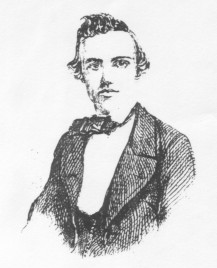
David Hooper (1915-98) voiced a number of criticisms of Edge in a review of Lawson’s book (BCM, January 1978, pages 33-34). There follow some excerpts from the review:
‘A journalist, Frederic Milne Edge, stirred up a dispute. This led to a myth, enshrined by a psychoanalyst, Ernest Jones, to the effect that Morphy’s retirement, and subsequent decline, was caused by Staunton’s refusal to play. However, the author points out that before Morphy went to Europe he had already decided to give up serious play when he returned home.’
‘One discerns the scheming hand of Edge, who made a handsome profit reporting Morphy’s exploits. Edge also found it profitable to invent baddies (Staunton, Harrwitz). As a consequence Harrwitz lost his job at the Café de la Régence. Staunton took Edge’s insinuations like a man, and never allowed them to influence his high opinion of Morphy’s skill.’
‘It is regrettable that Morphy should have been so misled, but he came to Europe alone, and Edge was helpful to him in many ways. In January 1859 the Morphy-Edge “friendship” was broken. Edge had got what he wanted, and he hurried home to be first in the market with a book about Morphy.’
‘In hindsight, he [Morphy] must have greatly regretted Edge’s influence which caused him to act so uncharacteristically.’
Hooper’s review called Lawson’s interpretation ‘biassed, with unfortunate results’. Whyld, his Companion co-author, also reviewed Lawson’s book, on pages 42-45 of the January 1980 CHESS. One passage follows:
‘Edge was a proven liar whose book on Morphy (“No gentleman would have written it” page 189) is often relied upon for unsubstantiated facts. No-one seems to have investigated the later life of Edge. Surely Morphy was not his only victim? The evidence against him is conclusive.’
For the record, the ‘gentleman’ quote from page 189 of Lawson’s book was written by W.H. Kent. However, Lawson wrote immediately afterwards: ‘The book hardly merits such utter condemnation.’
Hooper also set out his views on Morphy in the course of correspondence with us, and we subsequently reproduced some extracts. See C.N.s 3227 and 3235.
An historian who worked hard to rehabilitate Staunton up to and including the 1970s was R.N. Coles (1907-82). Howard Staunton, the English World Chess Champion by R.D. Keene and R.N. Coles (St Leonards on Sea, 1975) had the following remark on page 21:
‘Morphy’s ardent but polemical supporter, F.M. Edge, a reporter for the American Herald, published his version of the letters between the two men [Staunton and Morphy] in a form most damaging to Staunton and one which is by no means devoid of bias. The great majority of American chess writers since then, with the notable exception of Bobby Fischer, have suffered from what may be termed the Morphy-Edge syndrome.’
Whether Coles’ co-author shared that view is another question. At all events, 1975 was also the year that this appeared on page 174 of Chess Olympiad Nice 1974 by R. Keene and D. Levy:
‘We feel that the actions of the FIDE congress at Nice and those of the President, Dr Euwe, in particular, represent the biggest scandal the chess world has seen since Staunton refused to play a match with Morphy.’
Coles, for his part, reiterated to us in a letter dated 11 March 1978 that Lawson suffered from the Morphy-Edge syndrome, ‘like most American writers on Morphy’s relations with Staunton’. That viewpoint may be contrasted with an observation by Dale Brandreth on page 141 of the July 1985 APCT News Bulletin:
‘… the fact is that the British have always had their “thing” about Morphy. They just can’t seem to accept that Staunton was an unmitigated bastard in his treatment of Morphy because he knew damned well he could never have made any decent showing against him in a match.’
Making a general point about the Companion, Fred Wilson wrote on page 114 of the 1992 American Chess Journal, ‘There appears to be a clear anti-American bias in the book’. The issue of national bias does, unfortunately, require consideration in the Staunton-Morphy affair. In an attempt to achieve balance in our own book World Chess Champions (Oxford, 1981), for the Staunton chapter we picked Coles (England) and, for the Morphy chapter, David Lawson (United States).
It will be noted from the present article that the main criticism of Edge (an Englishman who was undeniably anti-Staunton) has come from his fellow countrymen. On the lack of a match against Morphy, Staunton has, over the years, been berated by writers of many nationalities, but the strongest general attacks on him have undoubtedly come from the United States, particularly from neo-historians of past generations. For example, in the Preface to his book A Treasury of British Chess Masterpieces (London, 1950) Fred Reinfeld wrote (page v):
‘There is no Staunton game – it takes too much time to find a game by him which one can enjoy.’
On page 9 of Napier’s Paul Morphy and the Golden Age of Chess (New York, 1957) Reinfeld wrote:
‘It may be true, as a noted psychoanalyst has claimed, that Morphy’s life was ruined by Staunton’s contemptuous rebuffs; but while Staunton’s tomes moulder in provincial libraries, Morphy’s masterpieces still continue to delight every generation of chess players.’
That is not to say that divisions have been on strict national lines. Many, though not all, historians have striven for objectivity, and some of the sharpest anti-Staunton barbs have come from England. The chapter devoted to him in Hartston’s The Kings of Chess is entitled ‘The Pompous Years’.
The first article specifically devoted to the Morphy-Edge relationship appears to have been by G.H. Diggle. Writing on pages 261-265 of the September 1964 BCM under the title ‘The Morphy-Edge Liaison’, Diggle stated:
‘Patrons of Edge’s book received undeniable value and entertainment for their money. Edge never wrote a dull sentence, or bungled a good story. His style is breezy, though somewhat coarse-grained, and the adulation of Morphy is sometimes bumptiously overdone.’
And a little later:
‘Unhappily, however, Edge is all too often more of a menace to a later historian than a help. For the book, with all its merits, is in certain parts one of the most venomous and untrustworthy in the whole of chess literature.’
In reply to Skoff’s criticism of his BCM article, Diggle said in C.N. 1012:
‘When I wrote “The Morphy-Edge Liaison” in 1964 I was a “fiery youth” of only 61, a lifelong admirer of Staunton who for four decades had witnessed my hero denigrated in potboiler after potboiler not only as the “cowardly evader of Morphy” but a producer of “devilish bad games”. As I considered that the main source of all this was Edge, I launched forth my “counterblast” in an attempt to redress the balance. If I have now lived to be myself “counterblasted” out of my “wheelchair”, I must accept this as one of the hazards of indiscreet longevity.’
The Staunton-Morphy-Edge debate in Chess Notes continued until the magazine closed down in December 1989, and summarizing here the multiplicity of points discussed would be an impossible task. The contributions – often of outstanding quality – did not always make for easy reading, but there can be little doubt of the material’s importance for all future writers on the nineteenth-century trio. For ease of reference, the numbers of the C.N. items in the debate are: 840, 943, 957, 1012, 1031, 1124, 1149, 1172, 1228, 1269, 1270, 1358, 1416, 1417, 1439, 1440, 1480, 1499, 1569, 1570, 1633, 1642, 1643, 1669, 1700, 1722, 1757, 1758, 1818 and 1932. Moreover, Skoff submitted a 16-page letter dated 17 November 1989 which arrived too late to be included in the final issue of the magazine; copies were made available upon request to interested readers.
In that letter Skoff wrote:
‘I have found Edge more reliable than Staunton: Edge did not cut out any crucial paragraph in any letter, as Staunton did, nor explode inaccurately in an Anti-Book statement, nor unfairly abuse his opponents, etc.’
Time and again, in C.N. and elsewhere, commentators have returned to the question of Edge’s truthfulness. The word ‘liar’ has been applied to him by a small number of (English, notably) authors, but what is the precise basis? That he was anti-Staunton is incontestable, but was being anti-Staunton a sign of mendacity, prejudice or, for that matter, clear-sightedness? Nor can it be denied that Edge’s prose was racy and anecdotal, yet that does not necessarily entail dishonesty. Edge unquestionably made factual mistakes and misjudgements, but if that sufficed to prove him a liar the queue in the chess world to cast the first stone would be short indeed. Can four or five thumping examples, absolutely clear-cut, of Edge’s alleged mendacity be set out on a single page of paper or screen (as they so easily could be regarding many other chess players and writers, past and present)? [This question was asked in 2000. The requested examples have not yet been forthcoming.]
In his final contribution to Chess Notes (C.N. 1932), published in the magazine’s last issue, Diggle drew the strands of the affair together and reported that he had begun to wonder …:
‘… whether Edge’s book did Staunton as much harm in the nineteenth century as what Goulding Brown called P.W. Sergeant’s “tremendous indictment” did to his memory in the twentieth. Edge’s book came out after the whole “Staunton Affair” had been chewed over by the Chess Press – interest was evaporating and faded away over the years. Indeed, when Staunton died in 1874 and Morphy followed ten years later, the respective obituaries scarcely mentioned their abortive match, apart from a brief unfavourable reference to Staunton’s conduct in the City of London Chess Magazine by W.N. Potter. But in 1916, with Edge half a century out of print, Sergeant revived the matter in his great classic which remained the standard work on Morphy for the next 60 years. In his findings he leant heavily on Edge, and he also recounted with some gusto Morphy’s juvenile joke about Staunton’s “devilish bad games”, a jest which so appealed to him that he repeated it both in Morphy Gleanings and A Century of British Chess. The result was that for several decades “prolific” chess writers (not having time for too much research) took their cue from Sergeant, and depicted Staunton not only as a “craven” (Reinfeld) best known as the man who avoided Morphy, but so weak that “it is just too incredible that … he could have achieved such success and exerted such influence for so long” (Horowitz). But at last a very great voice spoke and turned the tide. Bobby Fischer in a famous article included Staunton as one of the ten greatest masters of all time. Ray Keene and R.N. Coles followed ten years later with Howard Staunton, the English World Chess Champion, where his brilliant combinative powers were belatedly recognized. Since then Staunton’s fortunes have fluctuated; in David Lawson’s massive work (1976) he sinks somewhat, in the Companion (1984) he rises again, and in Chess Notes, stimulated by fresh discoveries, the Staunton-Morphy-Edge battle has raged ever since. But now that C.N., to whose pages the belligerents owe so much for their new material, is alas! coming to an end, will they agree to a “draw by repetition” or resume the fight elsewhere? Time alone will tell.’
Those words were written in 1989, and Diggle died some three years later. Throughout the 1990s the ‘Staunton-Morphy-Edge battle’ stood more or less adjourned, but around 2000 there were distinct signs of a revival of interest. The present article has provided a substantial quantity of information and views about the least-known of the protagonists, Frederick Edge, the aim being to ensure an informed debate on one of chess history’s most engrossing controversies.
***
With small differences the above article appeared at the Chess Café in 2000. See too pages 245-260 of A Chess Omnibus.
Contrary to what is sometimes supposed, when Morphy left Europe in 1859 chess did not flourish everywhere he had been. Here is part of a report on ‘The State of Chess in England in 1859’, from page 353 of that year’s Chess Player’s Chronicle:
‘With the transatlantic hero’s departure, however, a kind of reaction took place; and, as far as we remember, chess has never been so languishing in the metropolis, as in the latter part of the present year. Not even the presence of Herr Harrwitz was able to enliven the evident apathy of the chess players.’
(Chess Café, 2000)
Frederick Edge’s letter of 25 March 1859 to Daniel Fiske which contained the ‘lover’ remark was quoted in full in C.N. 1358 and in part on page 256 of Chess Explorations.
We now note that a full transcription of the letter has also appeared in an October 2003 booklet published by the Cleveland Public Library, Worlds of Chess Champions. The Library states that it acquired the letter recently.
The latest writer we have seen fall into the trap of believing that Edge was writing to Morphy is J.C. Hallman, on page 11 of The Chess Artist (New York, 2003).
(3187)
When an author (see C.N. 3255) who calls Harry Golombek Sir Henry Golombek ventures a one-sentence summing-up of the complex Morphy/Staunton affair the result is unlikely to be impressive. From pages 10-11 of The Sporting Scene by George Steiner:
‘The fairest assessment of this acid imbroglio would be that Morphy was justified when he asserted that Staunton was afraid to meet him across the board and that Staunton was using what influence he had to block the triumphant progress of a Yankee intruder.’
Given our admiration for the writing of Gilbert Highet it is no pleasure to quote from the article of his which was mentioned in C.N. 3232:
‘… the English dictator of chess, Howard Staunton, not only avoided a direct meeting with [Morphy], and refused to answer his letters, but snubbed him in the most brutal way, hinting in his chess column that Morphy was a crook who played chess as a method of swindling people out of their money.’
(3256)
In C.N. 1932 (see above and on page 260 of A Chess Omnibus) G.H. Diggle suggested that concerning the ‘Staunton-Morphy affair’ F.M. Edge’s attacks on Staunton inflicted less damage on the English master’s reputation in the nineteenth century than did the writings of P.W. Sergeant in the twentieth century. As G.H.D. pointed out:
‘… when Staunton died in 1874 and Morphy followed ten years later, the respective obituaries scarcely mentioned their abortive match, apart from a brief unfavourable reference to Staunton’s conduct in the City of London Chess Magazine by W.N. Potter.’
Below is the relevant passage from Potter’s article about Staunton, on pages 165-168 of the August 1874 issue:
‘His attacks upon Anderssen, Williams, Harrwitz, Löwenthal and Steinitz must ever be considered as a sad misuse of his vigorous intellect, especially as they were often conducted in a manner not at all consistent with a truthful spirit; nor were his innuendoes concerning Morphy otherwise than an utterly unworthy means of getting out of an engagement which he could have either declined with a good grace at first, or afterwards have honourably asked to be released from.’
G.H. Diggle’s interesting observation about other obituaries raises the question of historical perspective. Nowadays Staunton’s name is inextricably linked to the ‘Morphy affair’, yet we note that the obituaries of the Englishman in, for instance, Deutsche Schachzeitung and La Stratégie did not mention Morphy’s name even once.
(3273)
Notwithstanding the comments on the obituaries of Staunton and Morphy, it should not be imagined that after Morphy’s withdrawal from chess the controversy with Staunton was forgotten. For instance, in 1863 an article about Morphy on pages 33-39 of the Chess Player’s Magazine (edited by Löwenthal) included an extensive account of the non-match. So did ‘New thoughts on old subjects’ on pages 498-502 of the February 1882 Brentano’s Chess Monthly, in which Staunton was criticized heavily, and not least for maltreating Morphy in his 1860 book Chess Praxis (‘it was written at Mr Morphy’). Below is another comment, from page 500 of the article:
‘Staunton’s last work (Praxis) on chess is one which no student would like to be without, but it affords as many occasions for a pitying smile at the weakness of the author as for the expression of any other sentiment. The various forms taken by his constant determination to depreciate Morphy are of themselves a source of much harmless mirth.’
An article on ‘Mr Staunton as an Author’ on pages 161-164 of the December 1874 Chess Player’s Chronicle commented about Chess Praxis as follows:
‘This was an attempt to remedy the bad effects on the chess community of a stereotyped Handbook, for which as we have seen Staunton was not responsible; the work is well and carefully done, but disfigured by a somewhat grudging acknowledgement of Mr Morphy’s genius. Mr Staunton himself informed us that the Praxis was commercially a failure, as was to be expected in the case of a book, however meritorious, of a supplementary character.’
Parts of Chess Praxis were incorporated into Staunton’s Chess-Player’s Handbook (London, 1915). That book’s reviser, E.H. Bermingham, wrote an 11-page biographical note which fulsomely praised Staunton’s expertise (‘one of the greatest chessplayers that any country has produced’) but criticized his conduct vis-à-vis Morphy. Little seems to be known about Bermingham, beyond a small number of game-scores and his connection with Dublin chess. See, for instance, page 37 of A History of the Dublin Chess Club by A.A. Luce (Dublin, circa 1965).
(3278)
One aspect of the life of F.M. Edge (Morphy’s secretary and a key figure in the Morphy-Staunton controversy) which has so far received insufficient attention is his newspaper work before, during and after the New York, 1857 tournament. In the Preface (page vii) to his book Slavery Doomed (London, 1860) he wrote:
‘The Author of this work has enjoyed peculiar advantages for the study of the important issues now agitating the United States. A resident during five years in that country, he witnessed many of the occurrences herein related, while professional duties in connection with the press, during the last Presidential election, introduced him, as it were, behind the scenes, and afforded him the opportunity of becoming personally acquainted with many of the leaders of opinion in the American Republic.’
As Edge’s Preface was dated May, 1860 he was referring to the election of James Buchanan in 1856. On page 5 of his book on Morphy, Edge stated that in the summer of 1857 he was working for the New York Herald, and page viii of Fiske’s book on the New York, 1857 tournament contained the following credit:
‘In writing the diary of proceedings in the third chapter I found myself greatly aided by the daily reports in the New York journals, and chiefly by those from the pen of Mr Frederick M. Edge, who performed the duties of an assistant Secretary to the Congress with zeal and assiduity.’
Nonetheless, the entry on Edge in the 1992 edition of the Oxford Companion to Chess asserted that in New York Edge had been ‘a reporter for the London Herald’.
The New York tournament was completed on 10 November 1857. A comment by Edge on page 12 of his Morphy book indicates that he returned to Europe the following March. Even in 1859 he was still contributing to the New York Herald (see page 183 of David Lawson’s Paul Morphy The Pride and Sorrow of Chess).
Is any reader able to look into what Edge wrote in his Herald reports? The main interest lies in finding further facts about Morphy and evidence, either way, about Edge’s accuracy and veracity.
(3307)
Addition (26 June 2005):
From Louis Blair (Urbana, IL, USA):
‘As regards G.H. Diggle’s claim (in C.N. 881) of justification for his 1964 BCM article “The Morphy-Edge Liaison”, he acknowledged after further discussion: “I did not pull my punches and one or two were arguably ‘below the belt’.” (C.N. 1012) and “There is indeed a sort of ‘no man’s land’ between fact and fiction into which I sometimes strayed, playing Edge by ear rather than from the music”. (C.N. 1228)
David Hooper’s assertion in the 1978 BCM that “Edge also found it profitable to invent baddies (Staunton, Harrwitz)” is quoted, but Diggle acknowledged in C.N. 1012 that Staunton’s “conduct in many respects cannot be excused”; moreover, Staunton himself ridiculed Harrwitz’s behavior (Lawson, page 132). Hooper’s review in the BCM identified no specific inventions by Edge that caused Harrwitz to lose his job at the Café de la Régence.
In the same review Hooper referred to the Morphy-Edge friendship being broken after Edge “had got what he wanted”, but the available evidence (Lawson, page 189, for example) is that the friendship was broken by Morphy. Hooper’s review also gave no source for his assertions about why Edge “hurried home”.’
Afterword:
Regarding Edge’s letter to Fiske of 25 March 1859, below are some extracts from our correspondence with K. Whyld:
K.W. to E.W.: 25 November 1982:
‘I have a great deal about Edge, some of which I have doubts about making available for publication (such as his claim to have been Morphy’s lover).’
E.W. to K.W.: 26 February 1983:
‘As you know, I take an interest in F.M. Edge. A few letters ago you mentioned a claim he made that he had been Morphy’s lover. I wonder if you would be prepared to give me further details of this, not necessarily for publication.’
K.W. to E.W.: 5 March 1983:
‘About Edge, I can say no more at the moment. I was given sight of some letters to help in writing the Companion, but I undertook not to publish anything or reveal their whereabouts. In the next few months, when I am up to date with much that has been neglected because of “the book” I will re-open the topic and see if I can get permission to release anything I find.’
K.W. to E.W.: 18 April 1985:
‘... I agree with Skoff that the word “lover”, in 1859 – perhaps even in 1939 – did not necessarily imply anything carnal. (Just as “having intercourse” meant simply holding a conversation).’
K.W. to E.W.: 14 March 1987:
‘It seems that Skoff had interpreted the quotation in the Companion as some sort of claim to a homosexual relationship. This was astonishing to me. Obviously the whole quote was metaphorical in that he was not saying he really was a brother or mother or that Morphy was a god. And as he well knows, in Victorian times the word “lover” did not imply a physical relationship. As I said to Skoff when I wrote to him 3 iii, our quotation showed that Edge had an unbalanced view of Morphy and the conclusion should be that any evidence from him that has no independent support should be treated cautiously.’
E.W. to K.W.: 23 March 1987:
‘I am surprised by your comment that “obviously the whole quote was metaphorical”. Your letter of 25 November 1982 referred to Edge’s “claim to have been Morphy’s lover”. Was that based on something other than the Edge-Fiske letter?’ (No reply to this question.)
E.W. to K.W.: 5 July 1987 (pre-publication discussion of a submission by K.W. to C.N. 1440):
‘Your point 2). Unless I am misreading your words, aren’t you on dangerous ground here? You seem to be saying that you knew in advance that the average reader would misunderstand the letter quote, but you didn’t consider it necessary to avoid that misunderstanding.’ (No reply.)
E.W. to K.W.: 13 August 1987:
‘Although I have not yet mentioned it in C.N., there is still the outstanding question (top of page 2 of my letter to you of 23 March) on the “lover” matter. Yours of 28 March did not answer it.’
K.W. to E.W.: 27 August 1987:
‘I cannot remember what was in my mind when I wrote to you on 25 xi 1982, but I doubt very much if I implied anything other than that Edge had made astonishing claims.’
E.W. to K.W.: 6 September 1987:
‘Edge: here you’ve rather lost me; I am puzzled as to what you could have had in mind in 1982 other than the now-published Edge letter.’ (No reply.)
E.W. to K.W.: 14 October 1989 (on preparations for the final issue of C.N.):
‘On one point in Mr Blair’s latest submission, I shall give a mise au point of my own, explaining that I was first alerted to the possible homosexuality angle by you in 1982.’
K.W. to E.W.: 20 October 1989 (in response to debate material for C.N. 1932, in which we revealed publicly for the first time what K.W. had written to us on 25 November 1982):
‘I regret that you have “moreaued” a light-hearted remark not intended for publication into a part of a serious discussion, although it does make clear why you had the inclination to consider the “homosexual” suggestion in the first instance. I have not checked, but did you respond to my letter of 25 November in any way that led to a fuller and more considered treatment of the Edge letter?’
(By ‘moreaued’, a private allusion, K.W. meant: taking an obvious joke and treating it seriously.)
E.W. to K.W.: 25 October 1989:
‘Your Edge question: it must be as easy for you to verify our correspondence as it is for me. If you do so, you will find that I alerted you to the possibility of my publishing your 1982 comment.’
K.W. to E.W.: 24 November 1989:
‘My 1982 comment to you was the first mention of the Edge letter to any other party and was really intended to arouse your curiosity. I feel it will sit ill in more serious discussion.’
E.W. to K.W.: 27 November 1989:
‘I considered myself obliged to publish your 1982 words. Naturally I made my intervention in the debate early enough to offer you every opportunity to reply.’ (No reply.)
By that time we had, in any case, all but given up with K.W., on account of his persistent muddling and distortion of many matters, quite apart from the Edge-Fiske letter. At his best, he was one of the best; at his worst, he was one of the worst.
On 30 January 2004 Dale Brandreth (Yorklyn, DE, USA) wrote to us:
‘As an aside on the Edge letters, I know that in one of your Chess Notes Whyld was quoted as calling Edge an outright liar for his comments on Staunton. My considered view is that at least Whyld, and possibly Hooper too, very deliberately started the Morphy homosexual rumor to besmirch Morphy. If you read all of Edge’s letters, I think you, or anyone else, would have to agree that there is no suggestion that they had any kind of homosexual relationship. That doesn’t prove that Morphy was not a homosexual, but why even ever bring it up unless there exists some evidence to support such a theory? Despite all the hoohaw about how great a student of the game’s history Whyld was, I still think he was extremely devious and I greatly distrust his judgments on many matters having to do with chess.
He often ill-concealed his bias.’
And on 1 February 2004:
‘Whyld repeatedly, in my experience, sought refuge in evasion and distortion when called upon to prove some of his assertions.’
An earlier comment by Dr Brandreth was in an e-mail message to us dated 3 August 2000:
‘I have never fully understood Whyld. With me he often just evades an issue or question. I suppose I am to be able to figure out what such non-responses mean, but I find that frustrating and inadequate.’
Dr Brandreth was the publisher of a book which K. Whyld edited: Reflections by David Hooper (Yorklyn, 2000).
See also the addition dated 24 October 2024 in Jeremy Gaige.
A particular feature of Thomas Frère and the Brotherhood of Chess by Martin Frère Hillyer (Jefferson, 2007) is that it discusses the Morphy-Staunton controversy from an interesting new angle: the enmity between Frère and D.W. Fiske (pages 71-94).
(4780)
Notes on the life of Howard Staunton by John Townsend (Wokingham, 2011) has just been published in a limited hardback edition of 100 copies.
The book also contains carefully-researched material about some secondary figures discussed in C.N., such as T. Beeby, F.M. Edge and J. Worrell.
(7038)
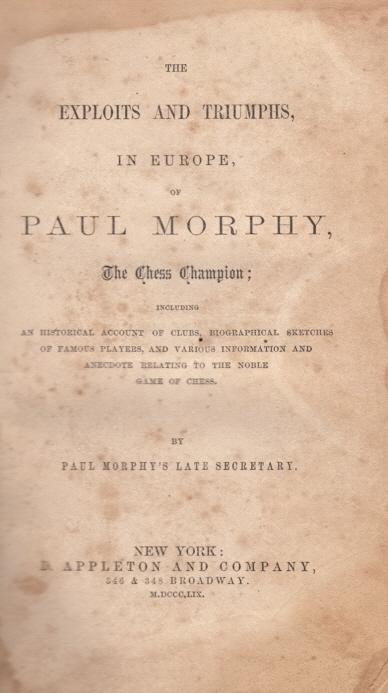
Over the past three decades much has been discovered about Frederick M. Edge (1830-82), and we are now grateful to John Townsend (Wokingham, England) for further information, including the fact that Edge served a prison sentence. Three announcements in the London Gazette have been found by our correspondent:
‘Frederick Milnes Edge, late of No. 49, Hanover-street, South Belgravia, in the county of Middlesex, Author, and now a Prisoner for Debt in the Debtors’ Prison for London and Middlesex, having been adjudged bankrupt by a Registrar of the Court of Bankruptcy, in London, attending at the Prison aforesaid, on 18 August, 1865, and the adjudication being directed to be prosecuted at the Court of Bankruptcy in London, is hereby required to surrender himself to William Hazlitt, Esq., a Registrar of the said Court, at the first meeting of creditors to be held before the said Registrar, on the 15th day of September next, at eleven o’clock in the forenoon precisely, at the said Court. Mr George John Graham, of No. 25, Coleman-street, London, is the Official Assignee.’
Source: London Gazette, 29 August 1865, page 29.
Mr Townsend comments:
‘Imprisonment for debt did not cease until 1869. Edge’s position was that of an insolvent debtor, but it was in his interests to qualify as a bankrupt, since otherwise he could have spent much longer in prison. To declare oneself bankrupt, one had to be a trader, owe more than £50, and petition the court. Edge’s claim to being a trader seemed to rest on his occupation as an author.’
The London Gazette of 3 October 1865, page 32 reported that Edge would be petitioning for his discharge the following month:
‘… a public sitting for the said bankrupt to pass his Last Examination, and make application for his Discharge, will be held before Edward Goulburn, Serjeant-at-Law, a Commissioner of the said Court, on 10 November next, at the said Court, at Basinghall-street, in the city of London, at 12 o’clock at noon precisely, the day last aforesaid being the day limited for the said bankrupt to surrender. Mr George John Graham, of No. 25, Coleman-street, London, is the Official Assignee, and Mr W.W. Aldridge, of No. 46, Moorgate-street, London, is the Solicitor acting in the bankruptcy.’
Our correspondent notes, however, that Edge was still behind bars in March of the following year. Page 56 of the London Gazette, 2 March 1866 stated that a date for another hearing had been set:
‘... a public sitting for the said bankrupt to pass his Last Examination, and make application for his Discharge, will be held before Edward Goulburn, Serjeant-at-Law, a Commissioner of the said Court, on 19 March instant, at the said Court, at Basinghall-street, in the city of London, at one o’clock in the afternoon precisely, the day last aforesaid being the day limited for the said bankrupt to surrender …’
Mr Townsend comments:
‘Edge was presumably released soon after this. Shortly afterwards he had a brief career as Secretary of the Northern Branch of the Reform League, but resigned on 11 January 1867 and sued his employer for libel on the grounds that a newspaper article imputed to him by innuendo that he had obtained money by false pretences, and attempted to collect money ostensibly for the League but really to be applied to his own purposes. Edge cleared his name. (See pages 119-120 of my book Notes on the life of Howard Staunton.)’
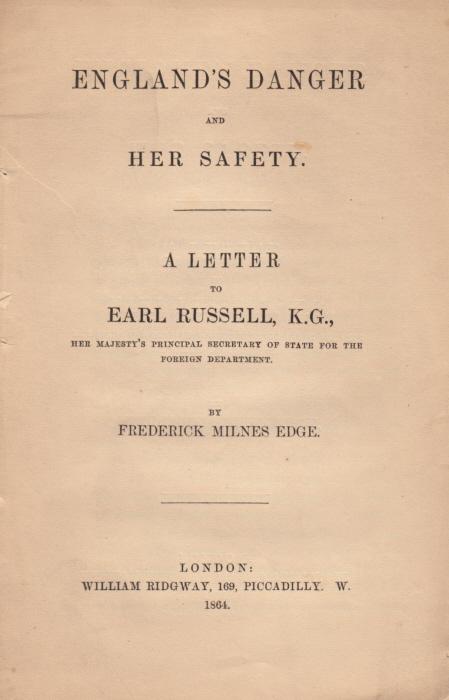
(7483)
John Townsend has found in the National Archives three letters to Lord John Russell (1792-1878) in connection with F.M. Edge. The first was written by Thomas Brett Chester, a solicitor who lived on the west side of London:
‘1 December 1860
My Lord,
I write to ask the privilege of an interview from you for Mr Edge a Gentleman possessing a master mind which for many years he devoted to travel in America for the purpose of studying their Political principles, economy and window of action specially in relation to Slavery. On returning to England he was resolved to write a work “Slavery doomed” denounced at the time as extreme if not futile in its anticipation but there were thinking Christian minds who felt its truth and force – and not a few in the Political world who acknowledged its remarkable ability. Recent & culminating events in America have fully proved in rapid sequence how thoroughly Mr Edge had studied & was able to grapple with his subject and to forecast the course of events which are only now in their commencement. Mr Lincoln’s advent must lead to an almost entire re-organization which will seriously affect England. As an Englishman then I entreat you to see Mr Edge. I am sure he will afford you truthful valuable information and insight into the working and probable results of the present struggle. Knowing the value of your time and the pressure of engagements I would not frivolously trespass upon you but I am sure you would be thankful for the interview.
I have the honour to be
Your Lordship’s most obedt. Servt.
T.B. Chester.The Rt. Honble. Lord John Russell’
On a separate piece of paper attached to this letter is written:
‘Mr T.B. Chester, 1 December 1856 [sic]
Asks interview for Mr Edge as a gentleman well acquainted with the state of America.
I should be glad to see him on Saty. at ½ p. 2.’
Reference: PRO 30/22/39, ff. 34-36.
‘To the Right Hon. Lord John Russell MP
Her Majesty’s Principal Secretary of State
For the Foreign DepartmentMy Lord,
I beg most respectfully that your Lordship will be pleased to accord me an interview believing that I am in possession of such information in reference to the present revolution in the United States as may be of service to Her Majesty’s Government.
I should not presume to trouble your Lordship were it not that personal acquaintance with American statesmen and politics of all parties enables me to foresee many dangers menacing this country; while at the same time, I might be permitted to offer a suggestion which, if carried into effect, would relieve our manufacturers from much anxiety.
I have the honor to be,
My Lord,
Your Lordship’s most obedient
and very humble servant,
Frederick Milnes Edge
49 Hanover Street, South Belgravia10 December 1860.’
On the reverse of this letter is written:
‘Mr Edge
10 December 1860
Information respecting
United States
Asks interview.’
Reference: PRO 30/22/39, ff. 37-38.
The third letter was written by Stephen Bourne. Mr Townsend notes that Bourne, who died in 1868 aged 76, edited the World newspaper, which was incorporated with the Patriot in 1831.
‘3 Melbourne Street, Brixton
15 December 1860
Dear Lord,
The last time I was at Chesham Place, I left with Your Lordship a book on the state of American Politics written by Mr Fred’k Edge. Since that publication Mr Edge has called on me several times.
The day before yesterday he informed me that he was to see your Lordship as this day but as he owed the appointment to a personal friend who is connected with the Conservative party he fears he may be ranked as one of them. He has asked me therefore to state to your Lordship, what I believe, that he is on the Contrary an advanced Liberal. He is well informed on American Politics.
I will take the liberty of calling at Chesham Place some morning in hopes of getting five minutes with you after breakfast as I have something to suggest on the same subject.
Ever Dear Lord
Faithfully yoursStephen Bourne.’
On a separate piece of paper attached to this letter is written:
‘Mr S. Bourne
15 December 1860
Respg. Mr Edge.’
Reference: PRO 30/22/39, f. 39.
(7514)
From John Townsend:
‘Further to my short account of the libel case which F.M. Edge brought against Clayton in 1867 (see Notes on the life of Howard Staunton, pages 119-120), I have learned a little of the background to the case. Although Edge had been released from the debtors’ prison about March 1866 (see C.N. 7483), his financial position continued to cast dark shadows over his life and was the cause of his departure from his job at the Reform League, which involved collecting money and retaining a percentage for himself, and the consequent libel action.
A fairly detailed account of the case appeared in the Manchester Courier and Lancashire General Advertiser of 7 August 1867, page 4. This included, incidentally, the full text of his resignation letter, dated 11 January 1867, which, in a chance remark by Edge, provides further evidence that he was married (“… I must now seek the means for maintaining myself and those dependent upon me …”). The identity of his wife remains a mystery.
According to the newspaper article, his counsel made the point that the advertisement inserted by his employer to announce his departure was libellous because, by the manner of the League’s distancing itself from Edge, it created a situation in which any monies subsequently collected by him could be seen as not for the benefit of the Reform League at all and, hence, it would be thought that he was acting dishonestly.
The discussion turned to the matter of some money which Edge had borrowed from a certain Mr Clinch:
“The plaintiff had been to Mr Clinch and borrowed £15 on a promissory note payable on 2 February. The money was lent to enable the plaintiff to deliver his lecture on 31 January. For some reason or other the plaintiff had postponed the day of the lecture to 6 February, and Mr Clinch not seeing any advertisement of the lecture in the papers, went to the League office on 28 January to inquire about Edge.”
It becomes clear from W.J. Clinch’s evidence that Edge had acquired a bad reputation for borrowing money while he was working for the Reform League:
“… He inquired for Mr Edge. They told him he was not there, and spoke of him in such a manner as to arouse his suspicions. Clayton told him the fact was that Edge had been borrowing money from first one person and then another, and Mr Jacob Bright had been told his association with him would not be creditable. … Crossley said if he would push him he would get the money, because he would let in someone else. Witness added that he was afterwards examined by the executive committee as to whether he did not lend the money on the strength of the plaintiff being an agent for the League. His answer was that his connection as an agent for the League would be no inducement to him to lend money (Laughter).”
Edge cleared his name, a settlement coming about as a result of a suggestion from the judge. However, this description of his borrowing habits and his bad reputation, taken together with his earlier imprisonment for debt, raises further questions about Edge’s trustworthiness, which several chess historians had already doubted. He played a central part in the Staunton-Morphy controversy.’
(7545)
John Hilbert (Amherst, NY, USA) also contributes a passage about Edge, from page 410 of volume one of The Civil War by Brooks D. Simpson, Stephen W. Sears and Aaron Sheehan-Dean (New York, 2011). It is in a letter which Henry Adams (who was serving as his father’s confidential secretary during the latter’s term as minister to Great Britain in Lincoln’s Administration) wrote in London on 10 June 1861 to his younger brother Charles Francis Adams Jr.:
‘I have tried to get some influence over the press here but as yet have only succeeded in one case which has however been of some use. That is the Morning Herald, whose American editor, a young man named Edge, came to call on the Amb. He is going to America to correspond for his paper; at least he says so. If he brings you a letter, let him be asked out to dine and give him what assistance in the way of introductions he wants. He is withal of passing self-conceit and his large acquaintance is fudge, for he is no more than an adventurer in the press; but his manners are good, and so long as he asks nothing in return, it’s better to have him an ally than an enemy.’
On page 5 of his book about Morphy (New York, 1859) Edge referred to his work for the Herald, and John Hilbert comments that although the index to The Civil War (page 799) merely refers to ‘Edge (Editor)’ it can hardly be doubted that it was F.M. Edge.
(7546)
From John Townsend:
‘The prison in which Edge was held was the Debtors’ Prison for London and Middlesex, Whitecross Street; it was essentially the same institution which John Henry Huttman had known in 1838 and the early 1840s. The following information is extracted from a return made on 1 July 1865 of the prisoners “within the walls” of that establishment (source: Gaolers’ returns, Whitecross Street Prison, National Archives, B 2/19):
“Name: Edge Frederick Milnes
Date of Imprisonment: 23 May 1865
Creditor: George Best, Rochester Terrace, Westminster
Nature and Amount of Debt: Ca Sa. £30 6s.
Whether such Prisoner is willing or refuses to petition the Court of Bankruptcy, or is unable to do so by reason of poverty: Unwilling
Attorney: B. Peverley, 73 Coleman St.”
Next to Edge’s name have been added in pencil some not very legible annotations, which appear to read: “Adjd/insufficient/In prison.”
The entry “Ca Sa” is a normal abbreviation for Capias ad Satisfaciendum, which is understood to be a type of writ, which a creditor can have issued after obtaining judgment against a debtor, whose body then has to be produced before the court to satisfy the creditor the amount recovered by the judgment. The debtor is kept in prison until he makes the satisfaction awarded.
The period of confinement could, in earlier times, be very prolonged. However, new measures introduced in the 1861 Bankruptcy Act had aimed, generally speaking, to get debtors and bankrupts out of prison, and many were freed after the Act was passed. It is perhaps therefore a little surprising that Edge was kept in prison at a relatively late date for an amount as small as £30 6s.
The creditor, George Best, of 5 Rochester Terrace, Westminster, was listed as an auctioneer and upholsterer in the Post Office London Directory for 1865 (page 852). It is not known how Edge came to owe him money. The same directory (page 1278) lists Edge’s attorney, Benjamin Peverley, as a solicitor at 73 Coleman Street, EC.’
(7905)
Also from John Townsend:
‘There is an entry in the International Genealogical Index which suggests that F.M. Edge’s parents, Thomas Edge and Eleanor Milnes, married at Manchester Cathedral on 29 April 1829, and I have checked the full entry in the Cathedral’s register.
Regarding the uncertainty over the middle name of F.M. Edge (i.e. whether it was Milne, Milns or Milnes) it may be noted that Thomas Edge is described as “Widower, of the Parish of Saint John the Evangelist Westminster, Brass founder” and that the bride is listed as “Eleanor Milnes of this Parish, Spinster”. Both parties signed the register, the bride as “Eleanor Milnes”. One of the three witnesses was Elizabeth Edge.’
(7963)
John Townsend writes:
‘An announcement of a performance of Hamlet in the New York Daily Times (26 November 1855, page 5) suggests that F.M. Edge was already a journalist in New York by that time:
“THE HAMLET NIGHT. – It is respectfully announced that the representation of HAMLET will take place at the Academy of Music TO-MORROW, (TUESDAY EVENING) Nov. 27.
In its cast of characters, the names will be found of many of our authors, artists, and others well known, apart from the dramatic art. The play will be produced in a novel manner, and with all the unrivaled elegance and splendor, both of mise en scène and wardrobe, for which the Academy is distinguished ...”
The cast list included:
“Osric .......... Fred. M. Edge ......... Editor.”
Hamlet was played by C.T.P. Ware, who was described as “Dramatist”.’
Can further information about stage performances by Edge be traced? This new line of enquiry opens up the possibility of finding a picture of him.
(8285)
Descriptions of the physical appearance of F.M. Edge, together with much other information about him, have been discovered by Harrie Grondijs (Maastricht, the Netherlands) in the diaries of Thomas Butler Gunn. Below are some of the transcripts provided by our correspondent:
‘I, by the assistance of little Edge, hunted up Carroll, and got particulars of Med. Student matters for book. Also I’ve visited a Chinese Boarding House – in Cherry Street. Book grows apace. Correspondence kept up, as wont.
Little Edge is a character whom a page or two would be well bestowed upon had I the time to write ’em. He and little cockney cub Watson spent some two months or so sleeping in timber yards, desperately hard up, and Watson almost despairing. Little Edge told me lots of stories anent it, how they fished, caught an eel, and bartered it at cook-shop for grub, how he pawned his coat, how they held arguments on all sorts of things, with much more. He is the slimmest, frailest, weakest little spectacled creature you ever saw. He lives with a French modiste à la Paris.’
‘To Bellew’s in the morning and returned to Bleecker Street with him. Kelly and, afterwards, little Edge called in the afternoon, the latter telling me how he had been in the basement, where the fellows (Eytinge and Cahill) had drunk up a quart of gin that morning and Sol was perfectly insensible. Little Edge has got married to his Alsacian-milliner-mistress and talks of nothing but his position on the Herald and what he is going to be.’
‘Edge has returned to England, I hear. He owes money to Haney, and actually has borrowed from the boy who waits at Haney’s tavern without repaying him! An odd, little, weak, frail-looking creature, with spectacles and such a general feebleness of aspect that nobody would suspect him of the capacity to contain any vices. He is of good family, I believe, his father being quite wealthy. Edge behaved like a young ass, squandered money, went to races, betted [?] and then ran off to Paris. There he experienced some hard-up-ness, used to frequent theatres, going in free with the claque, When he came to New York it was with a considerable sum of money in his pocket, all of which he gambled away at Pat Hearne’s and other halls, Then he consorted with Watson, the low little cockney. I used to see them for the first time in the Pic Office, Watson being a hanger on of Thad Glover’s and little Edge an admirer and friend of Watson’s. The two did some starving together.’
‘Little Edge it seems is travelling about with Paul Morphy, the chess phenomenon. I saw a letter from the former, reprinted from a London paper, in today’s Herald. It was dated from a Parisian hotel. Edge knew Morphy here, and reported chess-playing for the Herald. He must be in his glory, just now.’
‘There is a book advertised, as detailing the exploits of Morphy, the “Chess Champion” in Europe, written by his “late secretary”, little Edge, whose name has appeared in juxtaposition with the celebrity during the last year or so. Edge got acquainted with Morphy when reporting the proceedings of the Chess Club in this city, for the Herald. He lost his position on the paper by attempting to get some man made a policeman and threatening to use the reportorial power he had in being “down upon” the officers in case of refusal. One wrote to Hudson, who expelled Edge. What a contrast must his recent experience of Paris, in connection with Morphy, present to his former visit, when he ran away from home, lived in a garret and obtained admission to the theatres by joining the claque! He’ll be sure to turn up in New York again, some day. Of all cities in the world it would suit him best.’
‘Little Edge up, prim, spectacled and conversational, talking American about the rebellion, which according to his opinion is to be extinguished in a month or so. He stayed an hour or more, Boweryem [?] being with us during the best part of it, and when he had departed, Edge said he wanted me to be the New York correspondent of the London Star. I had been expressing opinions decidedly opposite to those of that paper throughout the interview! Edge wrote for the Morning Herald in London; he says he has had interviews with Earl Russell, with the Duke of Newcastle, apropos of American affairs, knows Bright and other notabilities. He left his wife among her folks in Switzerland.’
‘With him down the long pier, and aboard a little steamer, in a violent north-east wind, almost a storm. After some half hour’s delay, put off for the Mississippi. Elwell was there, but left, before our departure. One of the last persons I saw was little Edge on one of the steamers, waving his hand in adieu.’
Shortly after the above extracts were posted, Gerard Killoran (Ilkley, England) pointed out that volume 19 of the diary (7 March 1862) has the following:
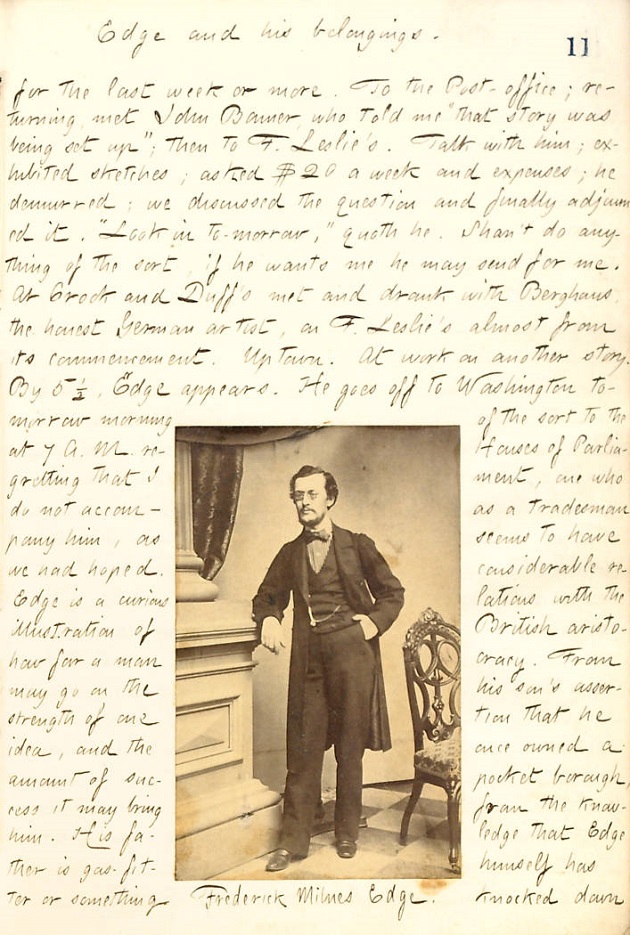
(9133)
From the diaries of Thomas Butler Gunn, referred to in C.N. 9133, Nick Lee (Tumwater, WA, USA) notes this entry dated 7 March 1862 (volume 19, pages 19-21):
‘I think I have recorded Edge’s antecedents heretofore; how he lived in Paris, visiting the theatres as one of the claque; how he starved about the timber yards of New York in company with Watson, in consequence of his receiving no remittance from home; how Levison helped him; how he married a little Alsatian prostitute of whom he has, now, the very highest opinion, to whom he duly remits a portion of his Star salary, and plenty of New York illustrated newspapers. Haney used to visit the pair during the Levison period and reported favorably of Mrs Edge. I saw her portrait at Amity Street the other night, coarsish but not unpleasing features and a profusion of hair. She lives in Alsace, whither Edge escorted her previous to his present American campaign. His parents recognize her, though an objectionable brother of his, whom I have some indistinct recollection of, as appearing in New York, went back home and told them what “Fred” had married! Haney lent Edge money which wasn’t repaid, he wrote to his father about it but the debt remained uncancelled until very recently; perhaps does so still. When Cahill learnt of Edge’s arrival here, from Washington, he in pursuance of an old grudge against him rushes to Haney with the news, with the name of the hotel Edge had put up at! Cahill has been Haney’s debtor himself in the past; of course is still! Edge’s book Slavery Doomed appears to be a good compilation, with common sense deductions from trustworthy premises. He dedicated it to Lord Brougham and considers it prophetic. He aspires to be not only a member of Parliament but future Premier of England! He professes to have had interviews with Lord John Russell, John Bright and half a dozen other notabilities, exhibits notes from them, and got his present commission at Bright’s instance. He talks with equal familiarity of American statesmen and celebrities and really seems to know many of them. Withal he has the agreeable habits of talking overmuch, too loud and getting close up to you in conversation. He would like to “capture” his ex-friend Paul Morphy, the chess-player, now in the Southern army.’
(9790)
In the late 1980s Frank Skoff sent us a ‘list of letters (plus some other items)’ in David Lawson’s book on Morphy:
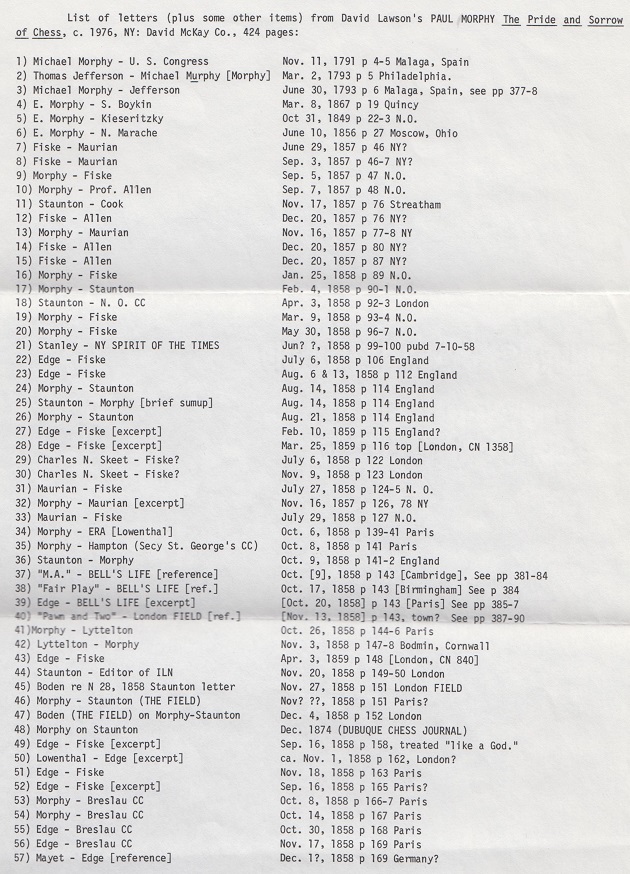
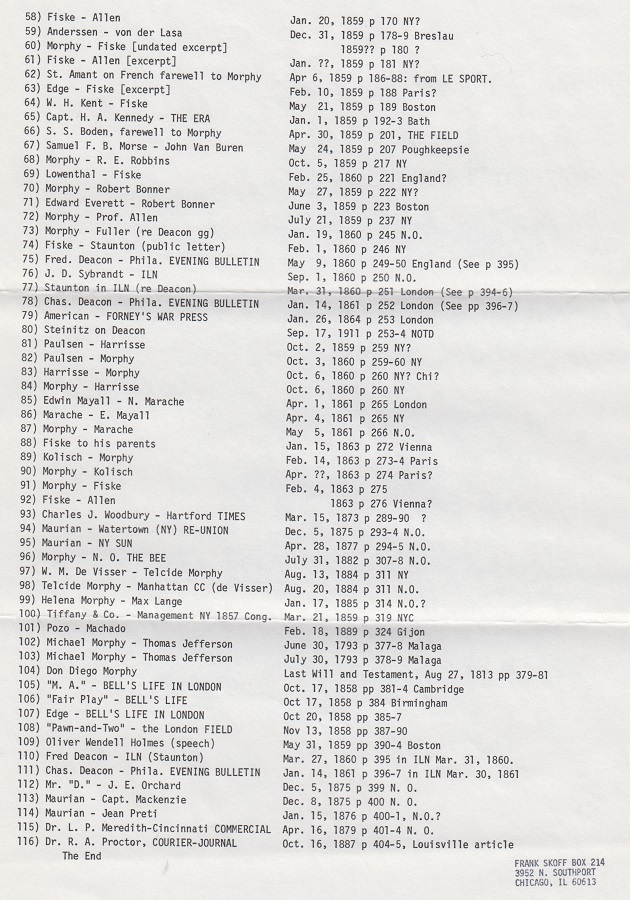
(10294)
A number of chess authors, and especially American and British ones in the twentieth century, could not, or would not, treat the Staunton-Morphy affair even-handedly. The passage below, written by Fred Reinfeld, is a bombastic example from what may be termed, in shorthand, the ‘pro-Morphy camp’:
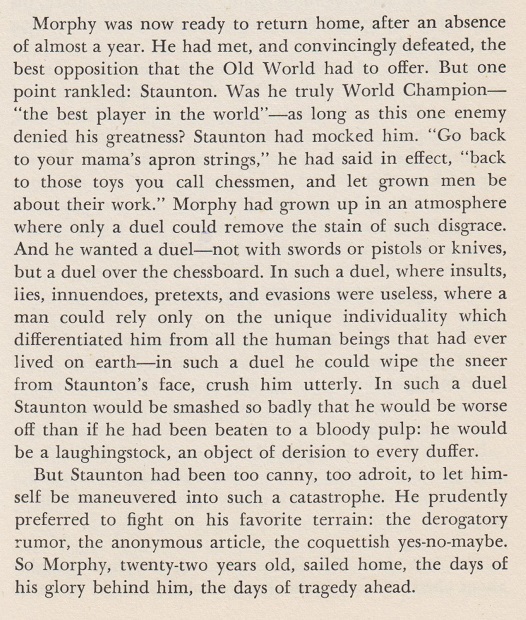
Source: page 65 of Reinfeld’s book The Great Chess Masters and Their Games (New York, 1952 and 1960). The text was on pages 71-72 of the UK edition, The Human Side of Chess (London, 1953).
(10412)
Goulding Brown’s defence of Staunton appeared at the end of a wide-ranging article about P.W. Sergeant’s first Morphy monograph on pages 191-194 of the June 1916 BCM:
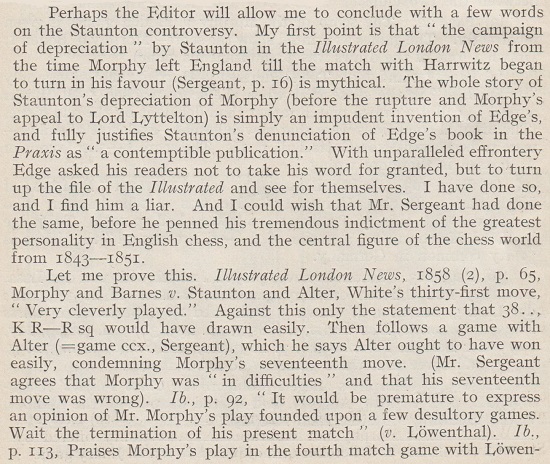
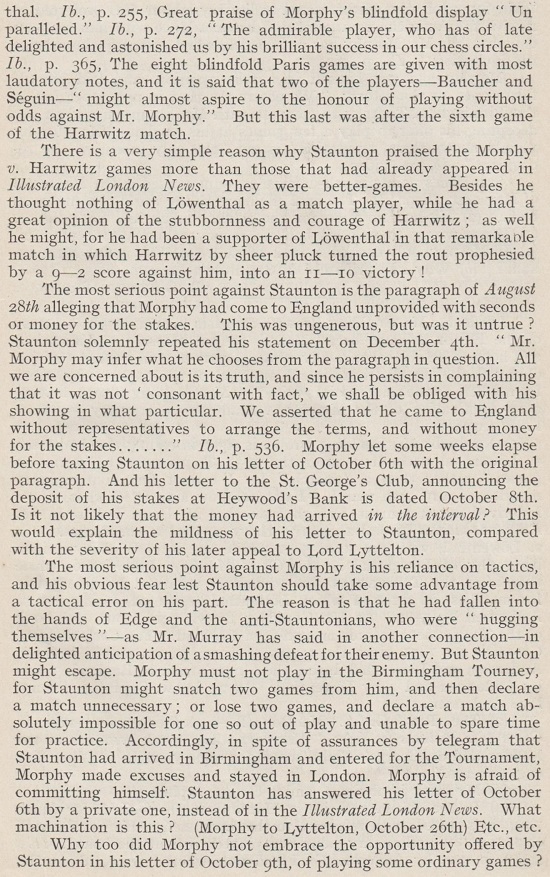
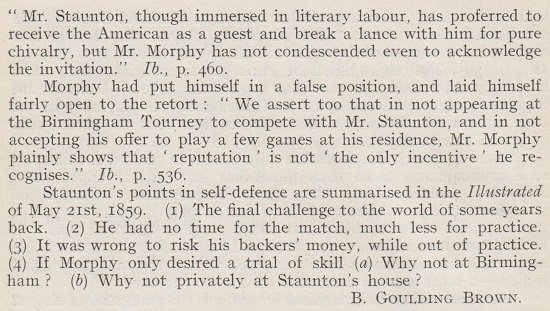
On pages 194-195 Sergeant responded to various points in the remainder of Goulding Brown’s article, ‘leaving a re-examination of the Morphy v Staunton controversy for some later occasion’. As shown [in the present feature article], Frank Skoff was highly critical of Goulding Brown. See too page 153 and pages 255-257 of Paul Morphy The Pride and Sorrow of Chess by David Lawson (New York, 1976).
(11328)
‘Staunton showed the effectiveness of the English opening, 1 P-QB4. Actually, his greatest impact on chess history was a negative one: by refusing to go through with a match against Morphy, he presumably effected the latter’s disillusionment and permanent withdrawal from chess.’
Source: page 17 of The Battle of Chess Ideas by Anthony Saidy (London, 1972).
(11425)
Page 2 of the Supplement to Bell’s Life in London, 31 October 1858 contained a brief correction:
‘We were mistaken in considering Mr Frederick Edge, Paul Morphy’s energetic friend, an American. Mr Edge is an Englishman, who had the honour to make Paul Morphy’s acquaintance at the New York great Chess Congress, where Mr E. officiated as one of the stewards.’
The previous week (page 3 of the 24 October 1858 edition) Bell’s Life in London had stated, ‘Mr Edge is an American merchant, travelling with Paul Morphy as his second and friend’. That came at the end of a letter from Edge on the Staunton-Morphy affair. For the full text, see pages 108-112 of his book on Morphy; page 143 of Lawson’s monograph gave only the final section. In the newspaper and in the Edge book the spelling of his name was ‘Frederick Milns Edge’, whereas Lawson put ‘Milne’. It may seem remarkable that Edge’s lengthy letter (approximately 1,500 words) was dated (Wednesday) 20 October and written in Paris yet could already be included in Bell’s Life in London on Sunday, 24 October.
(11542)
A paragraph from our present feature article Edge, Morphy and Staunton:
The Staunton-Morphy-Edge debate in Chess Notes continued until the magazine closed down in December 1989, and summarizing here the multiplicity of points discussed would be an impossible task. The contributions – often of outstanding quality – did not always make for easy reading, but there can be little doubt of the material’s importance for all future writers on the nineteenth-century trio. For ease of reference, the numbers of the C.N. items in the debate are: 840, 881, 943, 957, 1012, 1031, 1124, 1149, 1172, 1228, 1269, 1270, 1358, 1416, 1417, 1439, 1440, 1480, 1499, 1569, 1570, 1633, 1642, 1643, 1669, 1700, 1722, 1757, 1758, 1818 and 1932. Moreover, Skoff submitted a 16-page letter dated 17 November 1989 which arrived too late to be included in the final issue of the magazine; copies were made available upon request to interested readers.
Frank Skoff fully accepted that procedure.
Now, we give his 16-page letter as a PDF file, together with a one-page follow-up letter which he wrote on 20 November 1989 after seeing a preview of a comment by us in C.N. 1932.
Not all the C.N. items listed above are on-line, which means that parts of Frank Skoff’s letters will be unclear. However, there is no lack of clarity in his overall stance: strong criticism of certain British chess writers for inaccuracy and bias over the Edge-Morphy-Staunton controversy, with Kenneth Whyld singled out for excoriation.
(11801)
Addition on 4 December 2020: the full texts of the above-mentioned C.N. items are now on-line in a new feature article A Debate on Staunton, Morphy and Edge.
In a letter dated 22 June 1993, Dale Brandreth (Yorklyn, DE, USA) sent us some information about his dealings with David Lawson. His first two sentences:
‘In October of 1978 I purchased Lawson’s collection of Morphy material plus all his other chess material in his possession at the time – at least that was what our contract stated. Lawson, however, was an extremely devious and thoroughly dishonest man, as I then suspected and was later to find out beyond any doubt.’
On 4 December 2020 we added to our feature article on David Hooper a letter from him dated 22 February 1978 in which he wrote to us about Morphy:
‘I think Lawson’s book is lousy. ... The trouble with Morphy is getting some sort of objectivity. People are either Morphy-maniacs or, like myself, too disinterested to want to write about him. ... He was, of course, the greatest player of his time, but, after all, this reputation depends just upon three matches all played in five months of 1858. This is hardly proof of anything!’
C.N. 6811 (29 October 2010) reported regarding Lawson’s book that a paperback version edited by Thomas Aiello had recently been published by University of Louisiana at Lafayette Press. It added extensive biographical information about Lawson.
On 12 April 2013 (C.N. 8032) we acknowledged receipt of a French translation of the book by Gilles David, entitled Paul Morphy: La Gloire et la Tristesse des Echecs.
C.N. 11837 recalled that since the first appearance of the Oxford Companion to Chess by D. Hooper and K. Whyld, in 1984, particular attention had been paid to this section of the Paul Morphy entry on page 217:
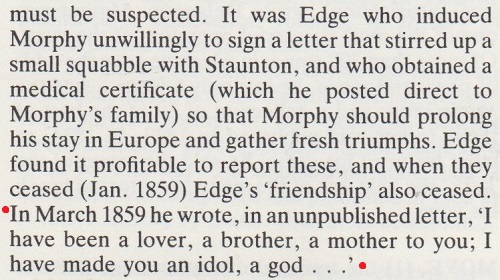
Our item added that in the revised edition of the Companion (1992) Edge had his own entry, and that the highlighted quote was on page 120:
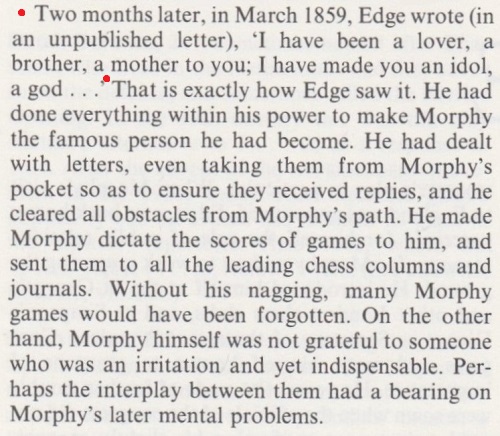
With Fiske’s name omitted as the recipient of the letter, it was natural to assume that Edge had been addressing Morphy direct. For example, the following is from page 11 of The Chess Artist by J.C. Hallman (New York, 2003):

In C.N. 1932 Louis Blair had written:
‘If the quote had been part of a letter to Morphy, it could be interpreted as a reminder, given by Edge to Morphy, of a secret between the two men. Such an interpretation is not possible if the letter was written to a third party. Given the commonly held negative attitude toward homosexuality, it seems most unlikely that Edge would hint at a homosexual relationship to a third party if there really were such a relationship. Thus when one knows the true nature of the quote, it makes homosexuality seem less likely instead of more likely.’
Below is the paragraph written to us by Kenneth Whyld on 25 November 1982:

From the Endnotes section on page 256 of our 1996 book Chess Explorations:
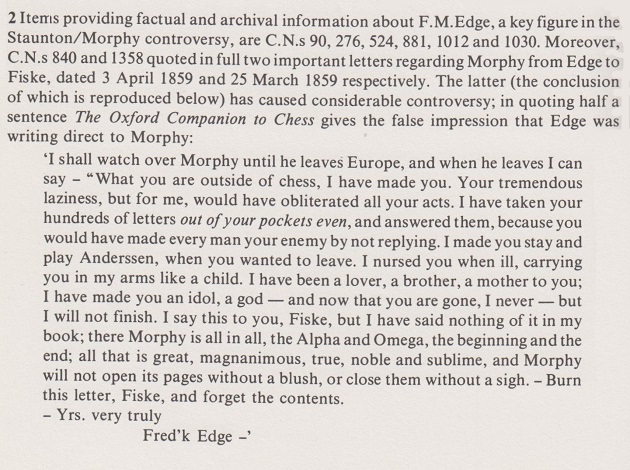
On page 190 of his 1976 monograph on Morphy, David Lawson wrote regarding Edge’s book:
‘Maurian reviewed it favorably in the New Orleans Sunday Delta, 5 June 1859.’
At our request, Eduardo Bauzá Mercére (New York, NY, USA) has provided Maurian’s column (page 8) which contains the ‘review’:

Mr Bauzá Mercére adds the following from the Chicago Press and Tribune, 11 June 1859, page 2:
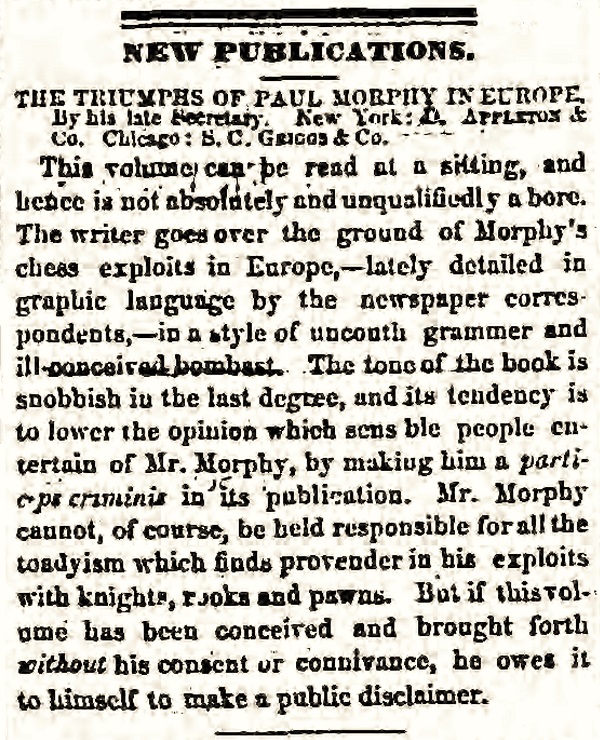
The quartet of feature articles Edge, Morphy and Staunton, A Debate on Staunton, Morphy and Edge, Supplement to ‘A Debate on Staunton, Morphy and Edge’ and Edge Letters to Fiske has expanded so much that certain sections have inevitably become amorphous.
Is it nonetheless possible at this stage to draw further conclusions in some of the discussion strands, such as F.M. Edge’s dependability as a chronicler?
(11854)
From John Townsend:
‘The question posed in C.N. 11854 referred specifically to Edge’s dependability “as a chronicler”, but perhaps it will help to consider his dependability as a person, especially considering that in recent years our knowledge of Edge’s life and character has advanced so markedly. Thanks for that are mainly due to Chess Notes and the “quartet” of feature articles mentioned in C.N. 11854. As a result, we have access today to much information which was not known to twentieth-century historians, such as Lawson and Sergeant, and this has particular bearing on his dependability.
In what follows, “Feature Article 1” means Edge, Morphy and Staunton, and “Feature Article 2” means Edge Letters to Fiske.
Overall, the picture of Edge which has emerged in recent years is an unfavourable one, which casts serious doubts over his trustworthiness and honesty.
Edge was born into a respectable family in 1830 in Westminster, the son of a manufacturing businessman, and attended a boarding school on Jersey, before concluding his education at King’s College London; however, he left after one year, having been frequently absent from lessons and examinations. (Feature Article 1.)
The diaries of Thomas Butler Gunn, which were reported to Chess Notes by Harrie Grondijs, contain surprising revelations and new insights into Edge’s lifestyle and character (Feature Article 1). However, there is no indication that the diaries contain other than a faithful record; the writer shows no malice towards Edge, and, if anything, something of an affection for “little Edge” comes across.
The diary entry of 22 March 1858 recalls that as a young man Edge “squandered money, went to races, betted ...” (Feature Article 1). Exactly how early he fell into debt is not clear, but his habit of borrowing money and not paying it back became a familiar complaint by his associates on either side of the Atlantic, both in the 1850s in New York, and in the 1860s in England.
He “ran off” to Paris, and was subsequently a journalist in New York by 1855, where he “gambled away all his money” (Feature Article 1). The diary entry of 11 April 1856 mentions that he went through a period in New York of being “desperately hard up” and sleeping rough, including in timber yards. (Feature Article 1.)
In 1857 he “married a little Alsatian prostitute” (in the words of the diary), who had previously lived with him as his “mistress”.
At sundry times, he lived a Bohemian lifestyle and eked out a scrounging existence (Feature Article 1). A diary entry for 22 March 1858 notes that Edge had returned to England owing money to Haney and had even “borrowed from the boy who waits at Haney’s tavern without repaying him!” (Feature Article 1.)
If it is true, as was reported in a diary entry of 11 May 1859, that Edge abused his position as a journalist to threaten police officers unless they appointed his own choice of officer, then he must have been fortunate not to face criminal charges (Feature Article 1). He allegedly threatened to be “down upon” the officers in case of refusal. As it was, his only punishment was that he lost his job.
The amount of trust the diarist Gunn felt in Edge is amusingly, but tellingly, illustrated by a diary entry (volume 21, page 194: 23 January 1863) describing a visit by Edge to his room after he had gone to bed. When Edge turned the conversation to his money difficulties, Gunn recalls how he reacted:
“I took the hint by jumping out of bed and securing my purse ...”
Edge’s scrounging extended to finding a bed to sleep in. Volume 21, pages 193-196 (23 January 1863) refers to Edge moving about the house to find someone else’s bed to share, in some cases without the knowledge of the bed’s principal occupier. Edge’s nocturnal wandering was objected to by other residents. His reason was that his own landlady had inconveniently asked for the rent.
It is difficult to see how such a person could have been taken seriously in Victorian England; Gunn’s portrayal of him sometimes resembles that of a music-hall character. Yet it appears that Edge was capable of being credible in face-to-face situations, thanks to his personality. He even obtained an interview in 1860 with the Foreign Secretary, Lord John Russell (Feature Article 1). Gunn suggested (volume 9, page 107: 22 March 1858) that his impudence may have assisted him on such occasions:
“He did well as a reporter on the Herald, for his matchless impudence – which never looked like impudence in Edge – stood him in good stead. He would have walked up to the President with ‘Now I want you to tell me all about &c &c.’”
In London in 1865, Edge spent a short time in the debtors’ prison in Whitecross Street (Feature Article 1). In 1867, he had a job with the Reform Society in Manchester; it ended in a libel case in which Edge sued the society’s honorary secretary of the northern department, evidently for implying that he had attempted to divert money intended for the society to his own pocket (Feature Article 1). In reality, it seemed impossible to recognize a libel in the words of which he complained. He cleared his name after a settlement was suggested by the judge, but it came out during evidence that Edge “had been borrowing money from first one person and then another” and that he had acquired a bad reputation for it. (Feature Article 1.) That was consistent with the complaints which his associates had made about him in New York.
The various episodes described above strongly suggest that Edge was not a person to be trusted, and was also capable of being dishonest and corrupt. One can easily imagine that his lack of trustworthiness could have adversely affected the negotiations for the proposed Staunton-Morphy match, and there is, clearly, scope for that to have happened. Yet it is very difficult to point to concrete examples, and it is often not clear for which actions Edge was responsible, as opposed to Morphy.
For the match to come off, successful negotiations were needed which had to be based on satisfactory relations between the two sides. Staunton was not obliged to play, and he may have felt that he was making a personal sacrifice in trying to find the time for it. It was important, therefore, for Morphy to retain his goodwill if he wanted a match. In the event, relations deteriorated, and Staunton has taken the bulk of the blame for that, and for the failure of the match. However, several historians in the past have noted Edge’s anti-Staunton bias, and one wonders to what extent it was a deliberate policy. Was he “down upon” Staunton in the same way as he threatened to be “down upon” the police officers? His hostile attitude, to give just one example, is illustrated in a letter dated 6 August 1858 (page 2), in which he referred to Staunton as “the ‘Chess Pariah’ of the London world” (Feature Article 2). Staunton had no shortage of enemies, and also many supporters, but use of the word “Pariah” seems excessive. The bias appears pronounced in Edge’s book on Morphy.
Lawson was, surely, mistaken when he asserted, on page 109 of The Pride and Sorrow of Chess, that “Morphy was a self-willed person” who “made his own decisions” and that “Edge always played a subordinate role in Morphy’s affairs”. Examples are available which show, on the contrary, that Edge played a controlling and influential part in Morphy’s affairs, and that he was of a scheming mentality. Edge it was who insisted on the Anderssen match, despite opposition from Morphy and his family; Edge who engineered Morphy’s “jeremiad” to Lord Lyttelton, whereas Morphy would have taken no action; and who claimed to have taken letters from Morphy’s pocket, and so on. Lawson appears to have underestimated this aspect of Edge.
On page 101 of A Century of British Chess, P.W. Sergeant remarked that he did not consider Edge a liar, while Lawson (page 109 of The Pride and Sorrow of Chess) merely supported that view. However, there is no indication that either of them enquired into Edge’s background before making that judgement. Did the mere fact of his association with Morphy give him respectability in their eyes? Sergeant did, at least, acknowledge Edge’s anti-Staunton bias.’
(11855)
An item on page 385 of Kings, Commoners and Knaves which we originally gave at the Chess Café in 1998:
In an article on pages 148-155 of the April 1887 BCM Bird described Anderssen as ‘the king of all chessplayers’. He considered that ‘Morphy’s record, though great, is not superior to Staunton’s before, and Steinitz’s after him’. Bird’s article was reprinted in his book Chess History and Reminiscences (pages 79-87).
‘In the world of chess Morphy was supreme; he surpassed his most illustrious predecessors, Anderssen, Staunton, Labourdonnais and McDonnell, in their strongest points. He was more sound in his brilliancy, and more brilliant in his soundness.’
E. Freeborough, BCM, July 1894, page 292.
‘Paul Morphy’s games constitute a beautiful bequest to the chess world, and give aim and purpose to the modern chess master; they have magnetized chess and taught players to develop their game to the fullest extent and then await the opportune moment for aggressive play.’
Emanuel Lasker, in a lecture in New Orleans, 18 June 1907, reported on page 372 of the August 1907 BCM.
Blackburne offered his views in an interview with The Standard, from which the August 1910 BCM (page 338) printed an excerpt:
‘I think Zukertort was the best for a short time; but he fell off in a few years through ill-health. Steinitz was considered the strongest player, because he beat Zukertort in a match in the London Tournament of 1883. I played Zukertort in 1887, and beat him, but he was not himself at that time. The present champion, Dr Lasker, beat Steinitz ... in the last match Steinitz ever played. I think Dr Lasker is as good as Steinitz ever was in his best days. At the present time he is undoubtedly champion of the world. Morphy ..., in my opinion, would have been superior to Lasker or any champions of the modern school. He was my ideal of a chessplayer, and one of the greatest players, I think, who ever lived.’
In an article on pages 260-261 of the August 1940 BCM Mieses related that during a visit to New Orleans in 1903 he had had a conversation with Maurian.
‘His reminiscences were very fresh and reliable, and from them I gathered a vivacious and uncoloured picture of Morphy’s personality. Maurian having been a school fellow of Morphy’s, was two years younger than he and had been introduced by him into the secrets of chess.
I was, of course, chiefly interested in getting remarks by Morphy about the game of chess, about his opponents and concerning himself. In Morphy’s character a high degree of self-confidence, quite free from conceit, was combined with strict self-criticism. After his return from his first journey to Europe which, as is known, had been a very triumphal procession, he told Maurian that he was not at all satisfied with what he had done, since he was quite certain that he could play much better than he had shown. This was partly due to the fact that he had seldom met opponents even nearly equal to himself. He had a high opinion of Anderssen and of Heydebrand von der Lasa. Of the masters of the generation preceding his he most appreciated Labourdonnais; also he thought highly of Hanstein.’
Mieses also wrote:
‘I once asked [Paulsen] “Whom of all the masters you met over the board do you consider to be the strongest?” Louis Paulsen, who was generally known to be very reserved, especially concerning judgments about other masters’ qualities, replied, without hesitation: “Morphy”. In order to substantiate his opinion he added: “If you asked him after the game what he would have replied to this or that move, he at once, without considering, fully explained the continuations he had intended to play. Then one could not but realize, with admiration, how many possibilities he had taken into consideration and how far he had calculated ...”’
‘May I finally mention that, of the living great masters, Maróczy and Rubinstein have made a special study of Morphy’s games. They both told me that they believe him to be the strongest player that ever lived.’
The above sequence of quotes was given on pages 389-391 of Kings, Commoners and Knaves. A footnote on page 390 pointed out, regarding the first paragraph by Mieses, that Maurian was only 11 months younger than Morphy.
From Chess Thoughts:
A good historian knows when to be a waverer.
See too Edge Letters to Fiske, as well as A Debate on Staunton, Morphy and Edge, Supplement to ‘A Debate on Staunton, Morphy and Edge’ and Daniel Willard Fiske.
A further feature article, about K. Whyld, is Reliability Eroded.
To the Chess Notes main page.
To the Archives for other feature articles.
Copyright: Edward Winter. All rights reserved.